introduction
If you’ve ever been interested in AR, you’ve probably come across the Nreal brand. The company has been one of the most successful companies in the marketing of AR glasses, boasting an impressive sales figure of 100,000 units in 2022. The most popular product in their range is undoubtedly the Air glasses.
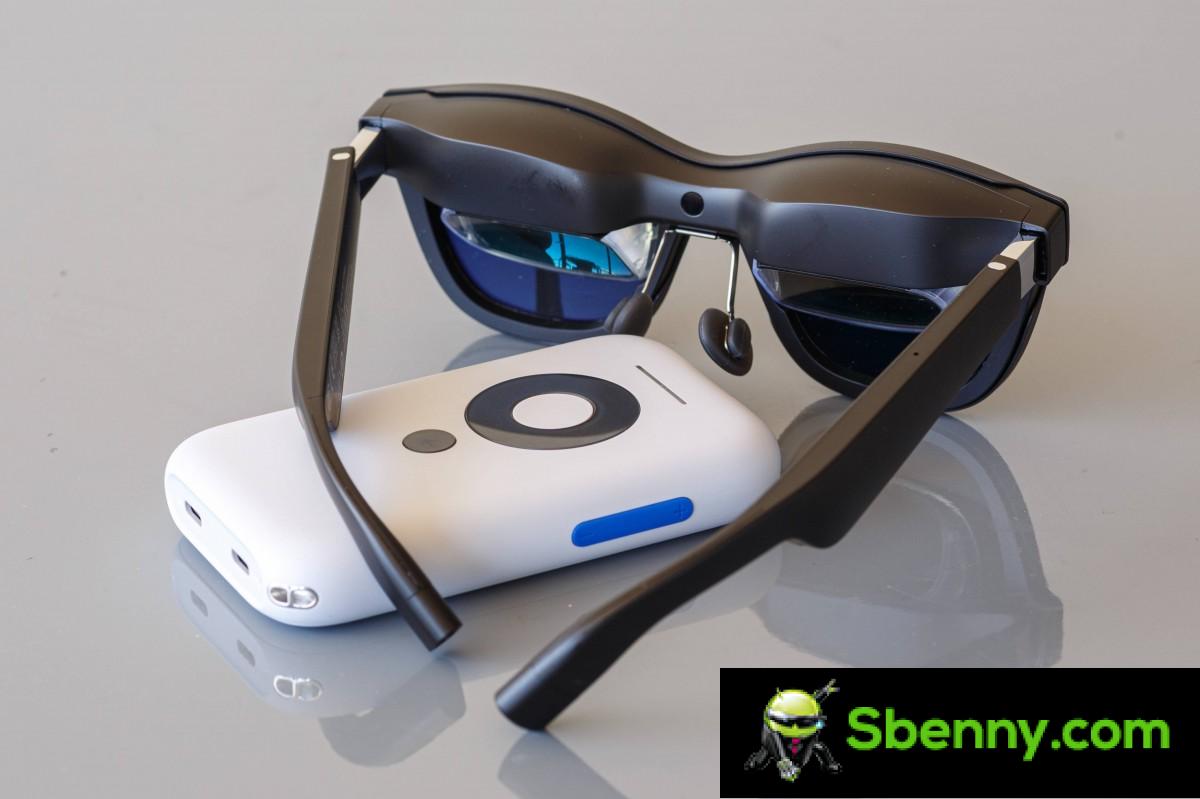
Nreal is now rebranding to XREAL after a trademark dispute with Epic Games. The company appears to have seized the name change as an opportunity and is now updating its range and in particular the XREAL Air goggles by launching an optional XREAL Beam accessory that further extends the functionality and compatibility of the Air goggles.
We had a chance to spend a couple of weeks with both products, and while the Air goggles have been out for a while now, we’ll start by taking a look at the goggles first and then moving on to the Beam and the new possibility that offers.

First off, we should probably clear up some terminology here and explain what the XREAL Air goggles actually do. You may find them marketed as XR glasses, which stands for Extended Reality and is actually an umbrella term that encompasses all VR (Virtual Reality), AR (Augmented Reality) and MR (Mixed Reality) products. The definitions start to get a little murky beyond that, but at its core, the XREAL Air is more or less a portable, wearable display. There’s no real onboard computing, but there are a few sensors, including an accelerometer, gyroscope, magnetometer, and proximity sensor. XREAL actually leverages these to provide head tracking when paired with the XREAL Beam or the Nebula app. So, technically, the Air goggles have all the prerequisites to be considered an AR product.
XREAL Air at a glance:
- Dimensions: 148mm x 52mm x 159mm (unfolded), 148mm x 52mm x 60mm (folded), 79 grams (without Type-C cable attached, including cable weight approx. 31 grams). 3-position vertical adjustment for gaze angle, fits head sizes from 120 to 186mm, 20 degree angle adjustable hinges.
- Optical Parameters: Dual Micro-OLED displays with 1920 x 1080 pixel resolution, 46-degree FoV, 60 Hz, 49 PPD (pixels per degree), 8-bit color, 108% sRGB, perceived brightness up to 400 nits, effective screen size: 130 inches , projected 4 meters away and up to 201 inches at 6 meters away in MR Space mode.
- Audio: Dual open-ear speakers with bass enhancement, dual microphones with omnidirectional MEMS.
- I:USB Type-C port for power and video via USB Type-C Display Port in alternate mode, power switch and brightness/volume controls on the right.
- Other characteristics:Accelerometer, gyroscope, magnetometer, proximity/wear sensor, 3 DoF head tracking, myopia attachable frame and extra nose clips in the box.
XREAL Beam at a glance:
- Dimensions: 105.8mm x 65.86mm x 18.2mm, 153 grams.
- Interior: 4GB RAM, 32GB ROM.
- Drums: 4870mAh (advertised for up to 3 hours of operation), up to 27W PD charging support.
- I: Two USB Type-C ports (one for XREAL Air goggles and one for DP video and power input), volume rocker on the right side. Display mode switch button on the left side, four-way controls, OK and back button on the front, multicolor LED status indicator strip, power button and fan air outlet on the top.
- Other characteristics:Built-in cooling fan.
Before we go any further, a word on pricing. The XREAL Air eyewear retail for $379, which is quite comparable to the $399 price tag of the TCL NXTWEAR S competitors we recently reviewed. Then there’s the optional XREAL Beam, which is priced at $109. Alternatively, you can buy both as a bundle, but you’ll pay the same $488 price.
Unpacking
XREAL Air goggles come with a lot of stuff in the box. In addition to the main unit, you get a very sturdy travel case with a zipper, two compartments and a lens protector for the front of the unit.
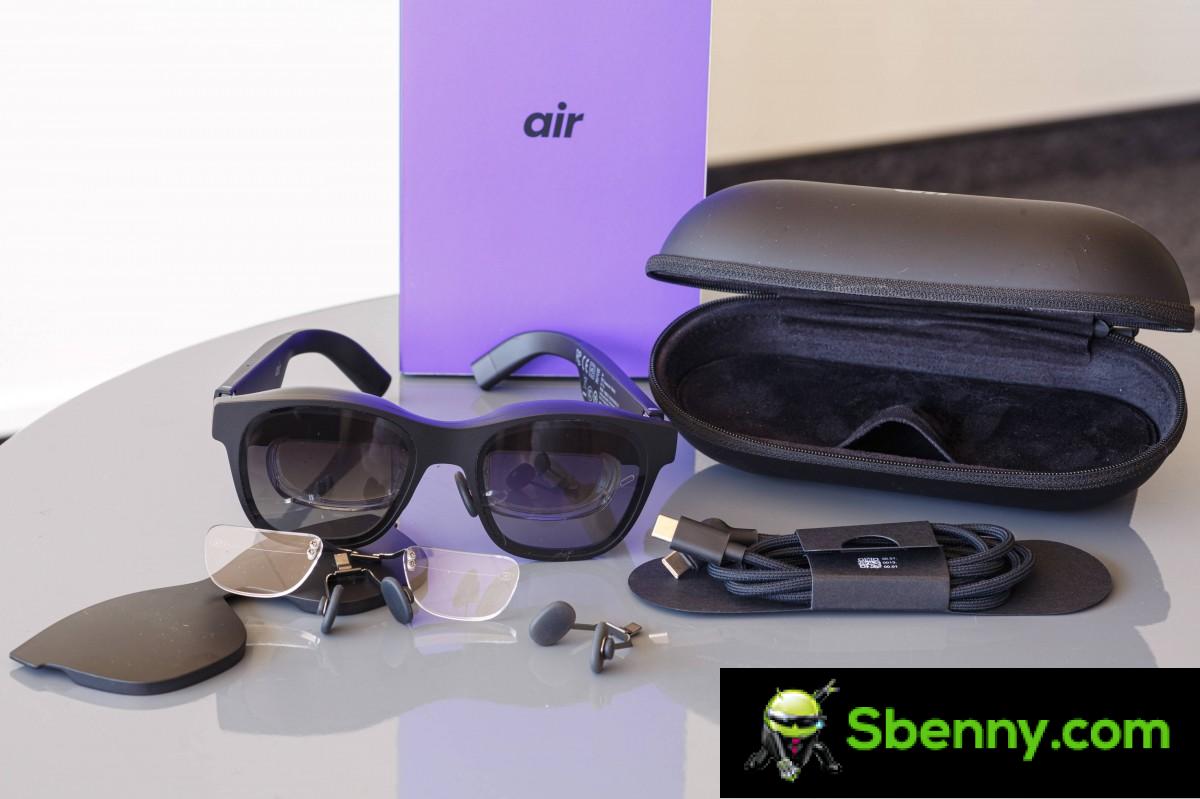
Three different sized nose pads are also included. Swapping them is a very simple process. The same fixing mechanism is also used for the included prescription lens frame. Also in the box is a plastic light shield to place over the glasses, a USB Type-C to Type-C cable, and a cleaning cloth.
The XREAL Beam, for its part, comes in a sturdy two-piece box with virtually no additional accessories inside. There is only the unit itself and some flyers.
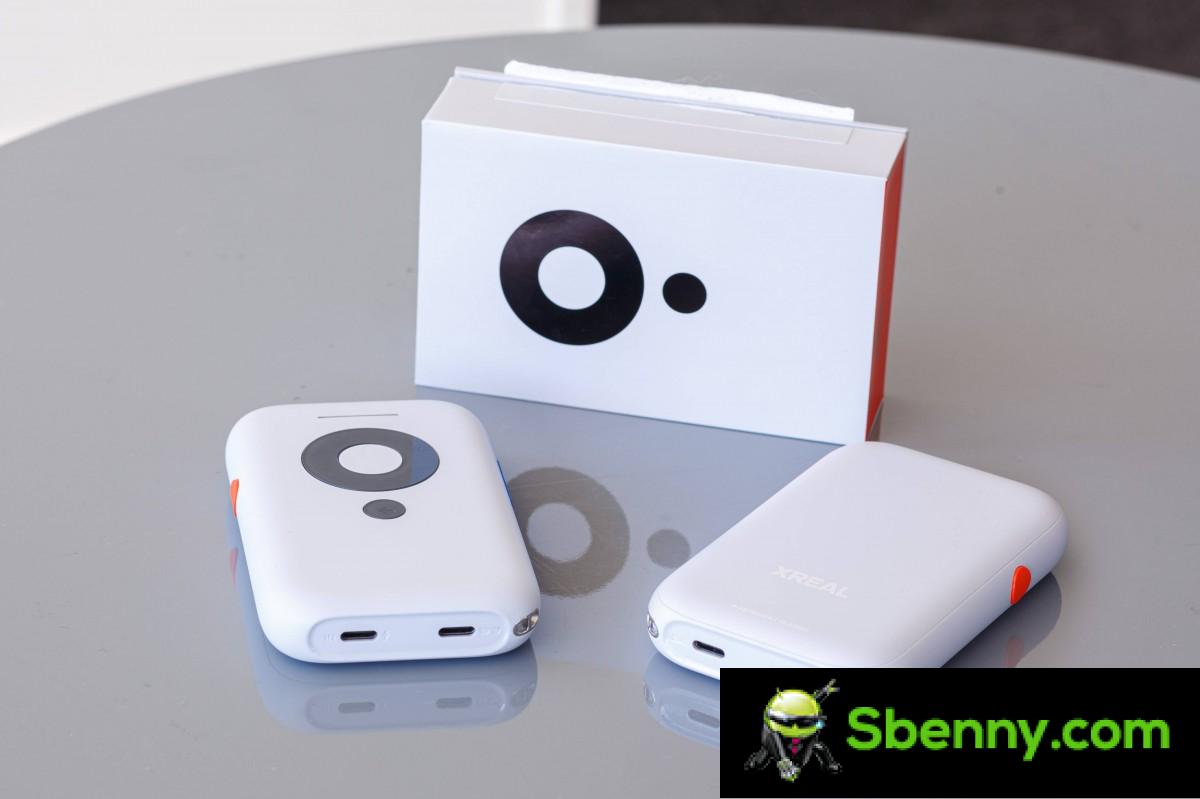
Hardware, features and controls
XREAL Air goggles are mostly made of plastic, which certainly contributes to their fairly light weight 79 grams. There really isn’t much hardware inside, other than Sony’s two FullHD OLED displays, a pair of speakers, and a few sensors. There is no battery, computing power or wireless connectivity hardware. All data and power is transmitted through the cable, which is the standard setup for AR glasses nowadays.
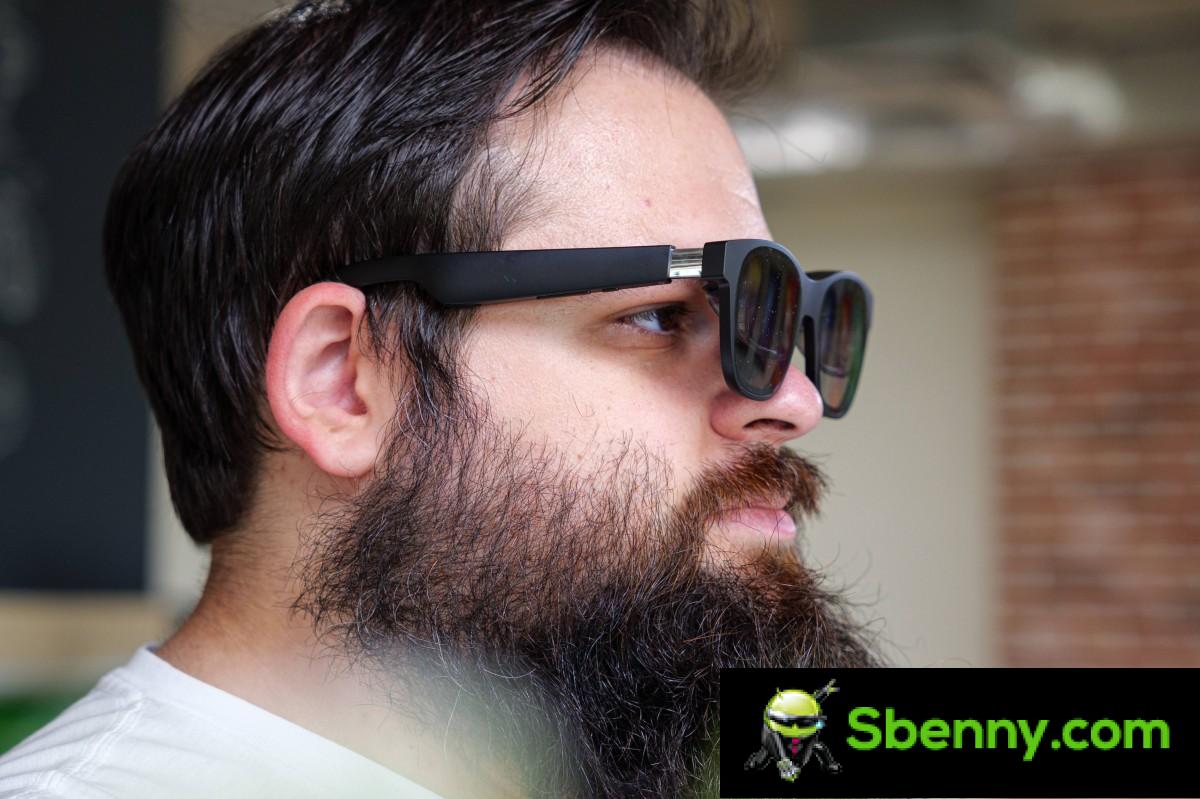
All of this also allows the glasses to be quite compact, measuring 148mm x 52mm x 60mm when folded and 148mm x 52mm x 159mm explained. The unit tends to fit snugly on the face, without too much wobbling or play, and it’s not heavy at all. However, it can put uncomfortable pressure on your nose after prolonged use.
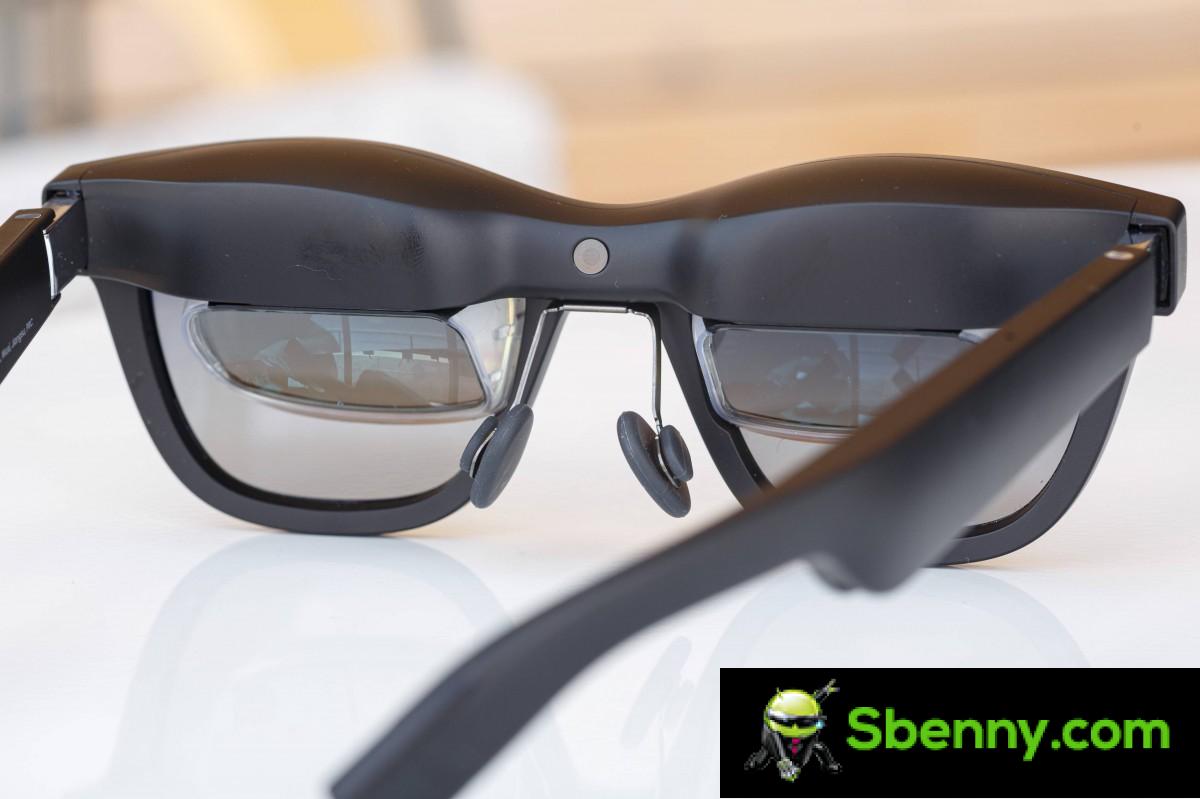
Let’s start our hardware tour from the front. The XREAL Air glasses are absolutely flat on this side and successfully sport a traditional sunglasses look with the lenses flush with the frame. This contrasts with some alternatives, such as the TCL NXTWEAR S glasses, which have a funky front look that immediately reveals their “smart” nature.
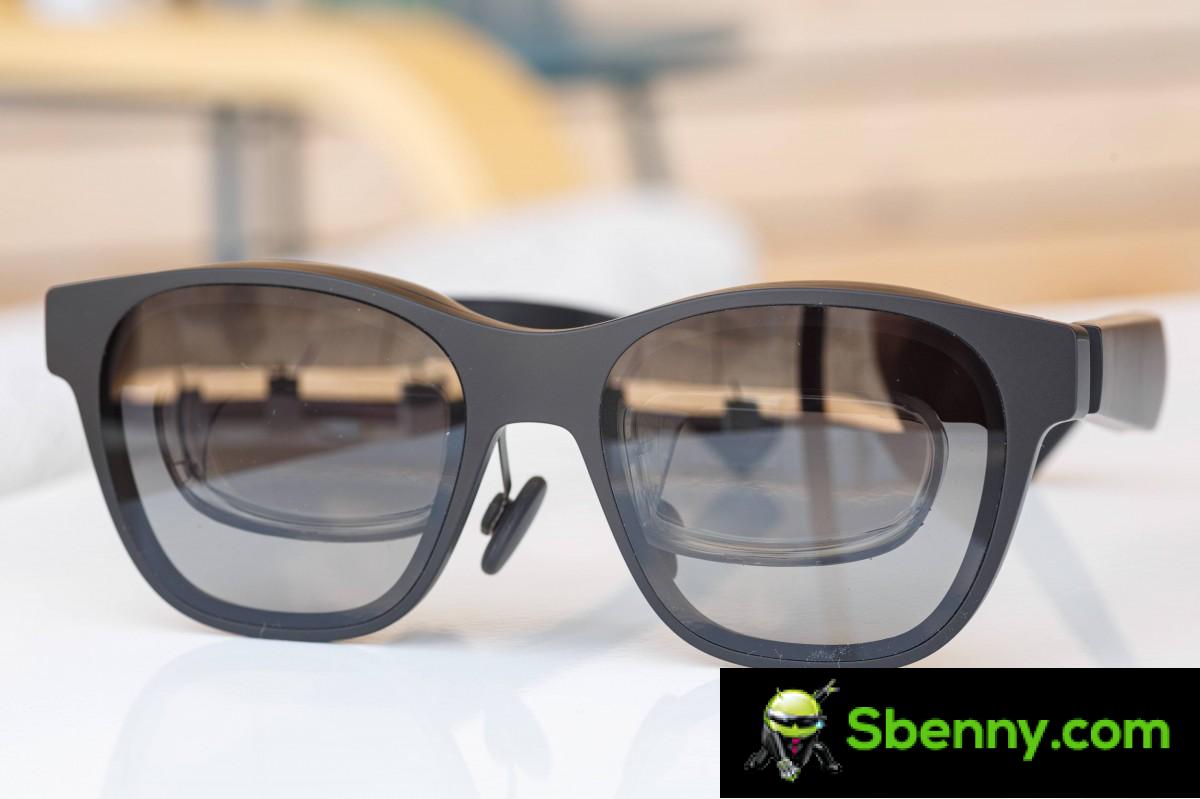
Going a little further than the TCL eyewear comparison, unlike the clear front lenses on these, XREAL Air has tinted tints by default. Just like NXTWEAR S, XREAL Air goggles have an optional snap-on attachment with solid shades. They don’t stick with magnets but are friction mounted to the top of the frame and sit very securely.
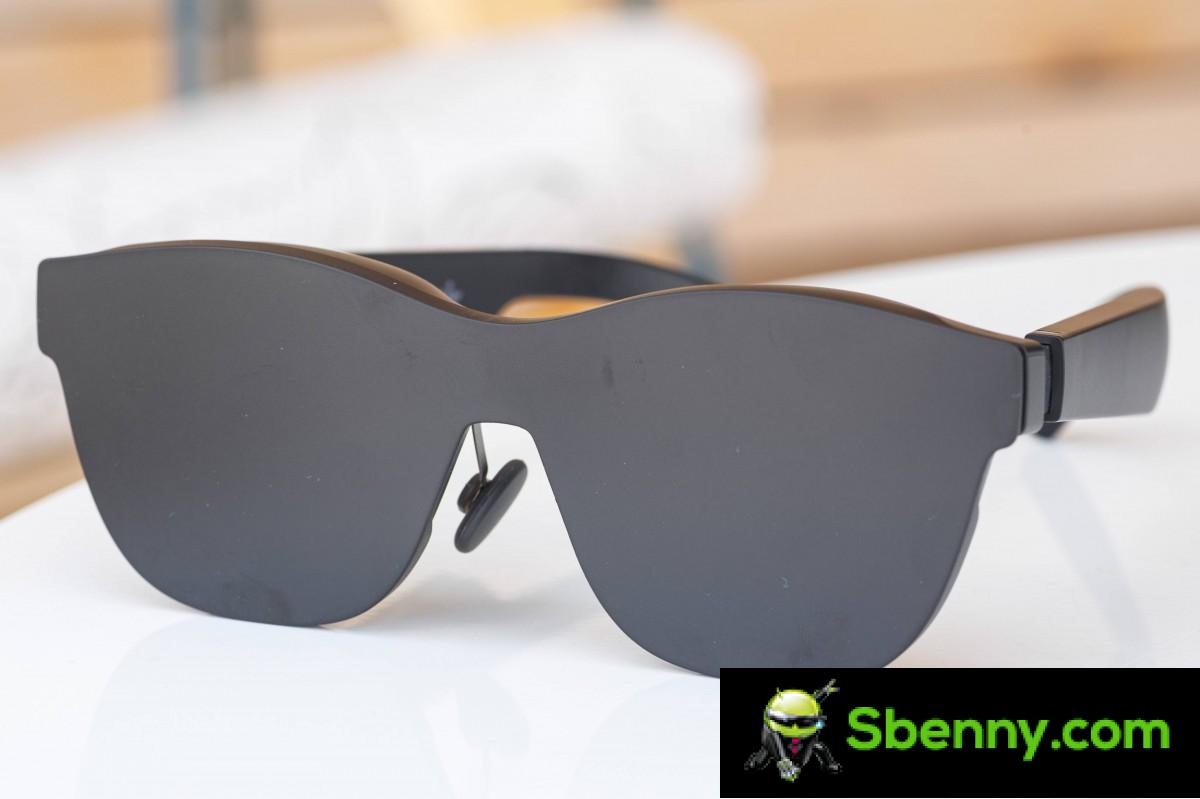
The lampshade attachments spoil the inconspicuous look of the XREAL Air glasses. It feels weird to wear fully blocked glasses. Then again, all it takes is a quick second glance and spotting the USB cable dangling from your ear to realize that something strange is going on, so you can’t realistically expect to go into “stealth mode” with glasses on.
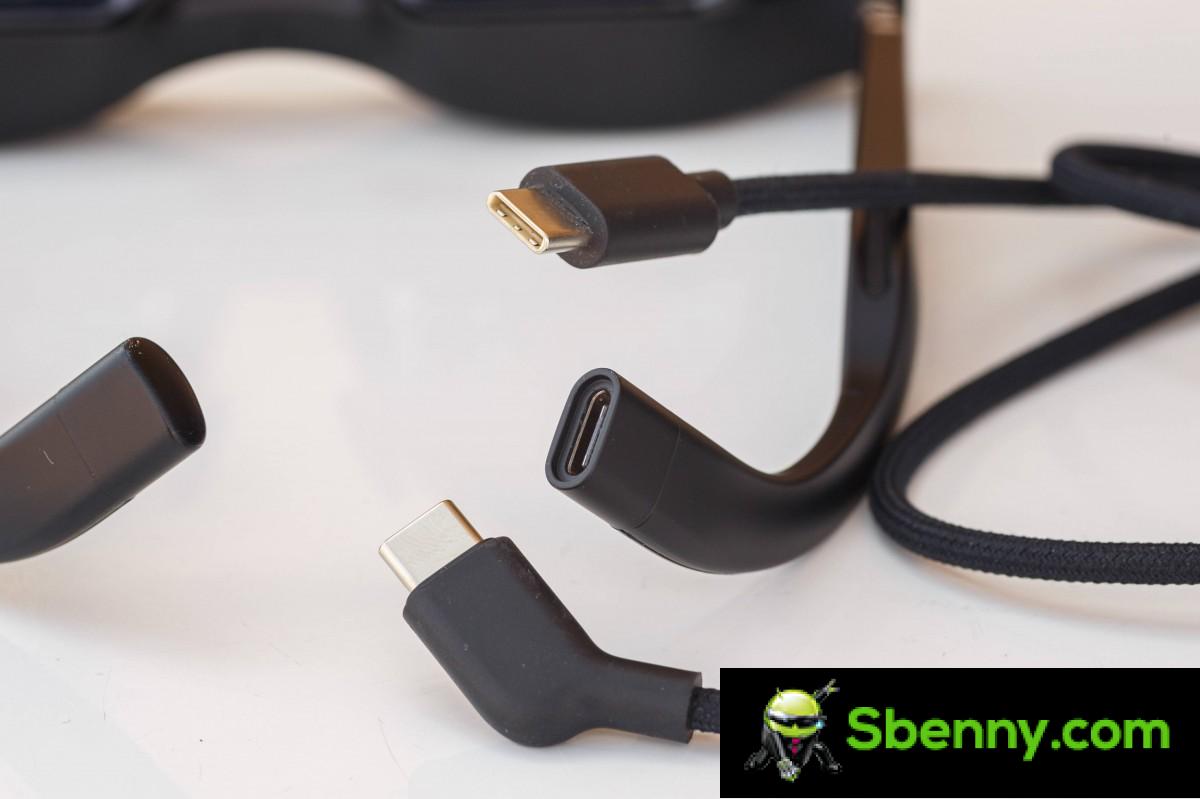
After all, the cable will always be plugged into the XREAL Air since it’s the only power and video source for the goggles. There’s a braided USB Type-C to Type-C cable, angled on one end to fit more snugly over the glasses that come in the box. You can use any of your own decent enough cables, but the one provided is pretty great. It is soft and flexible, yet very sturdy. It’s not too often either. We never found it in the way while wearing the goggles.
On the one hand, we like the Type-C connector with its strong physical connection. There’s virtually no chance of accidentally yanking the cable out of your goggles. However, that also means that if you happen to get caught, chances are you’ll knock your glasses off your face. The magnetic connector on the NXTWEAR S goggles is better in this regard.
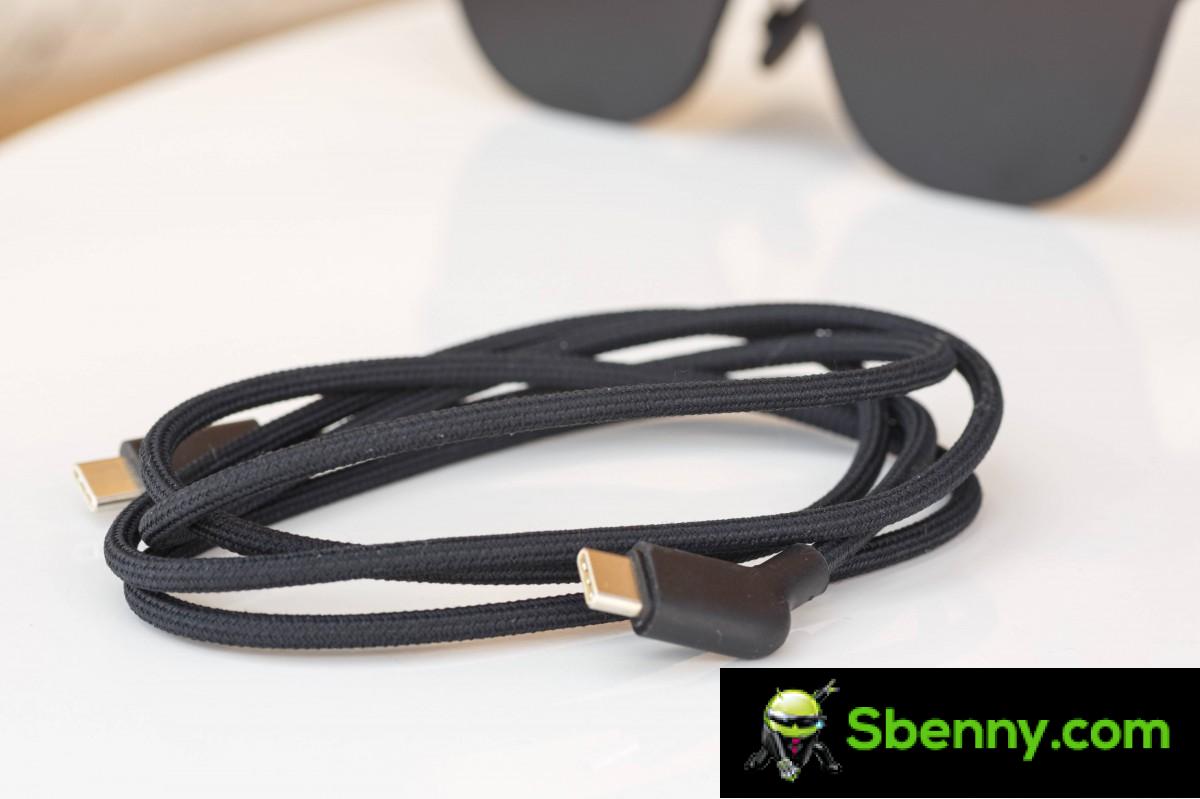
As far as cable length goes, we’ve never needed more than we have. It’s long enough to be comfortable while sitting in front of a device or holding it on your lap, and it also fits nicely into most pant pockets if you really feel like walking around with glasses on, which is admittedly weird but it can be taken out.
Let’s talk about the speakers for a moment. The XREAL Air has a pair, one on each arm. They are conventional compared to bone conduction units, which are sometimes included in wearable technology. The speakers actually have grilles pointing down towards your ears, which makes sense.
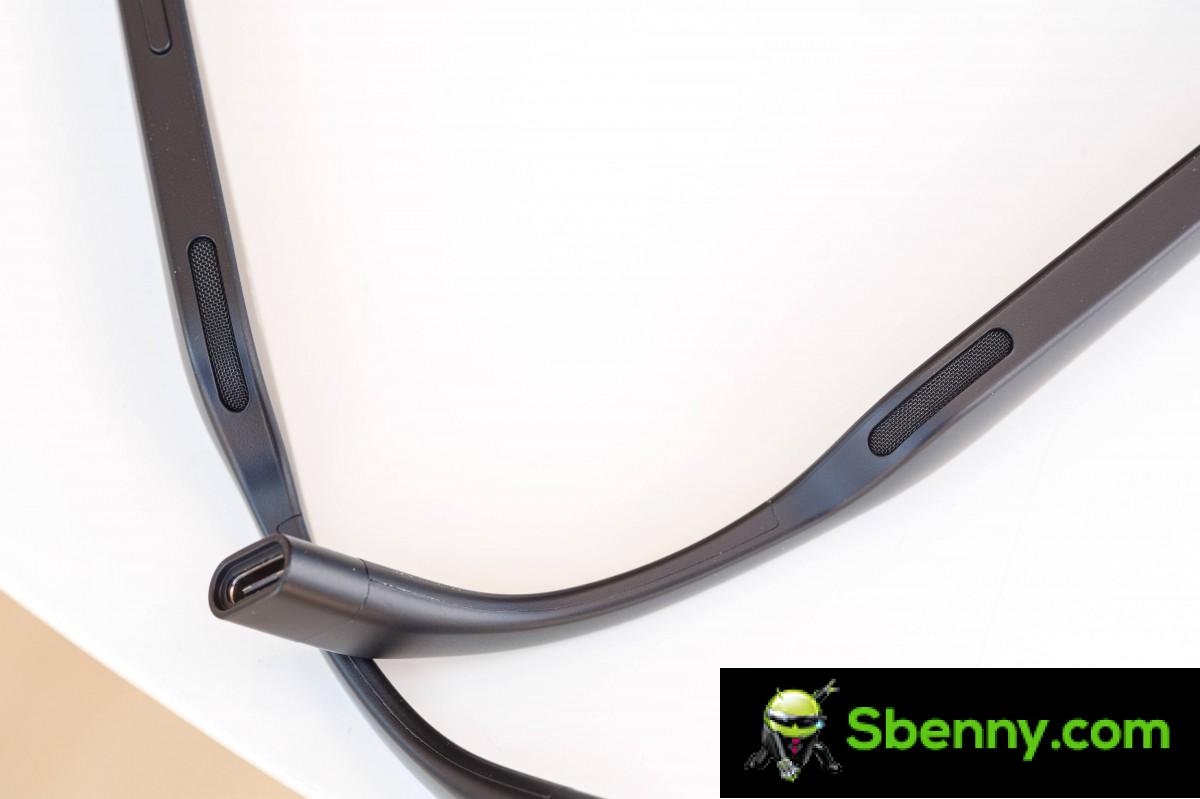
In practice, the speakers sound good, but only as good as can be expected from small units positioned a bit away from the ears. The output is relatively clean, with nice highs and mids and clean vocals. There’s absolutely no bass and it’s not particularly loud, which may have been a necessary trade-off to ensure minimal noise leakage. In practice, even at full range, the neighboring parties, even those sitting next to us, heard nothing, which is impressive.
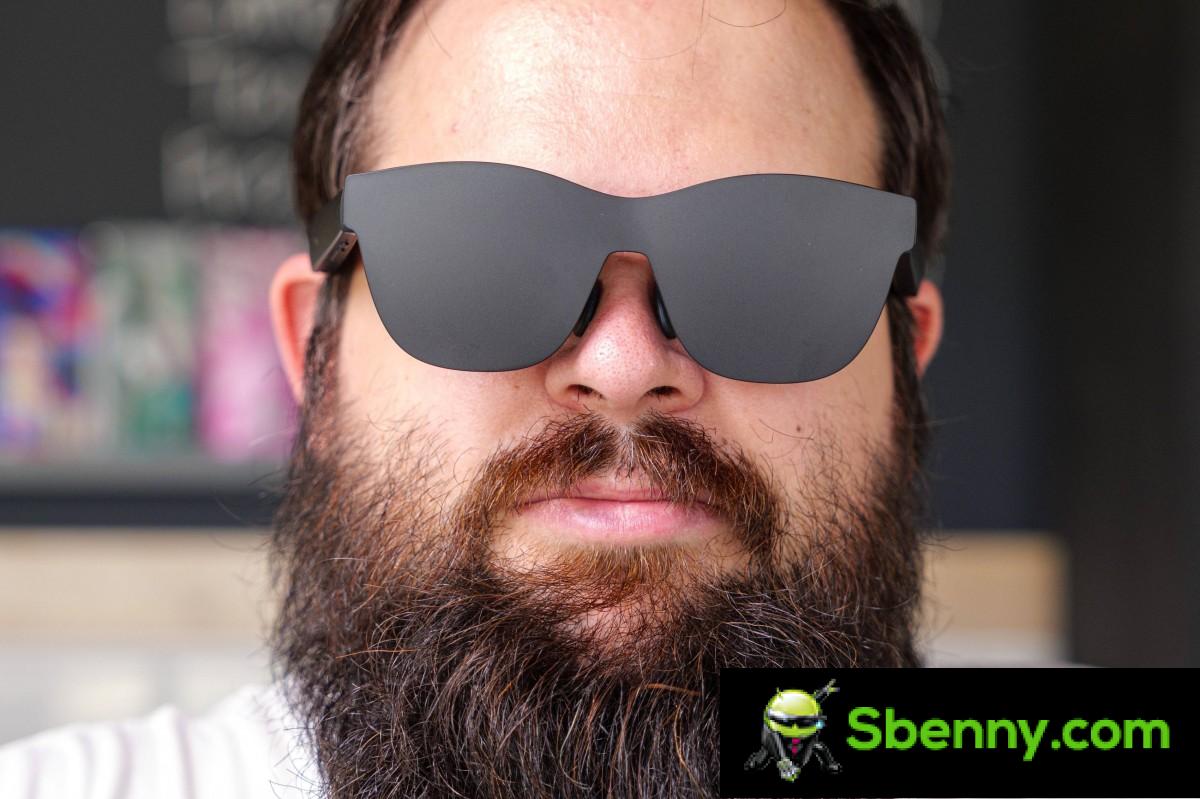
The XREAL Air has only one set of controls on the right arm. The rocker adjusts the brightness of the screen by default. You can also adjust the speaker volume by long pressing it. Then there’s a power button to turn the goggles on and off, and next to that, a status LED.
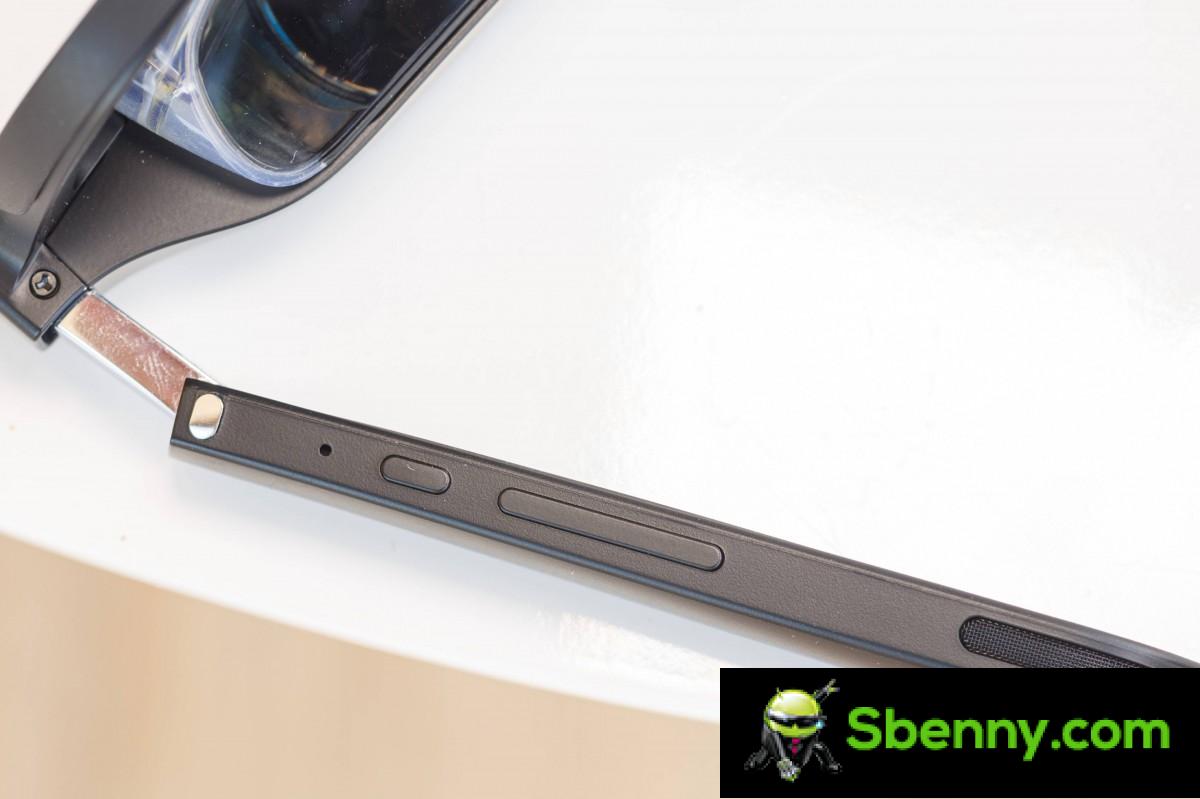
XREAL Air goggles have a fantastic extra feature: a wear sensor. It’s positioned in the center of the glasses, just above the nose pads, and appears to be a simple proximity-based unit. Works great and turns the glasses off seconds after you take them off and turns them back on almost instantly once you put them back on.
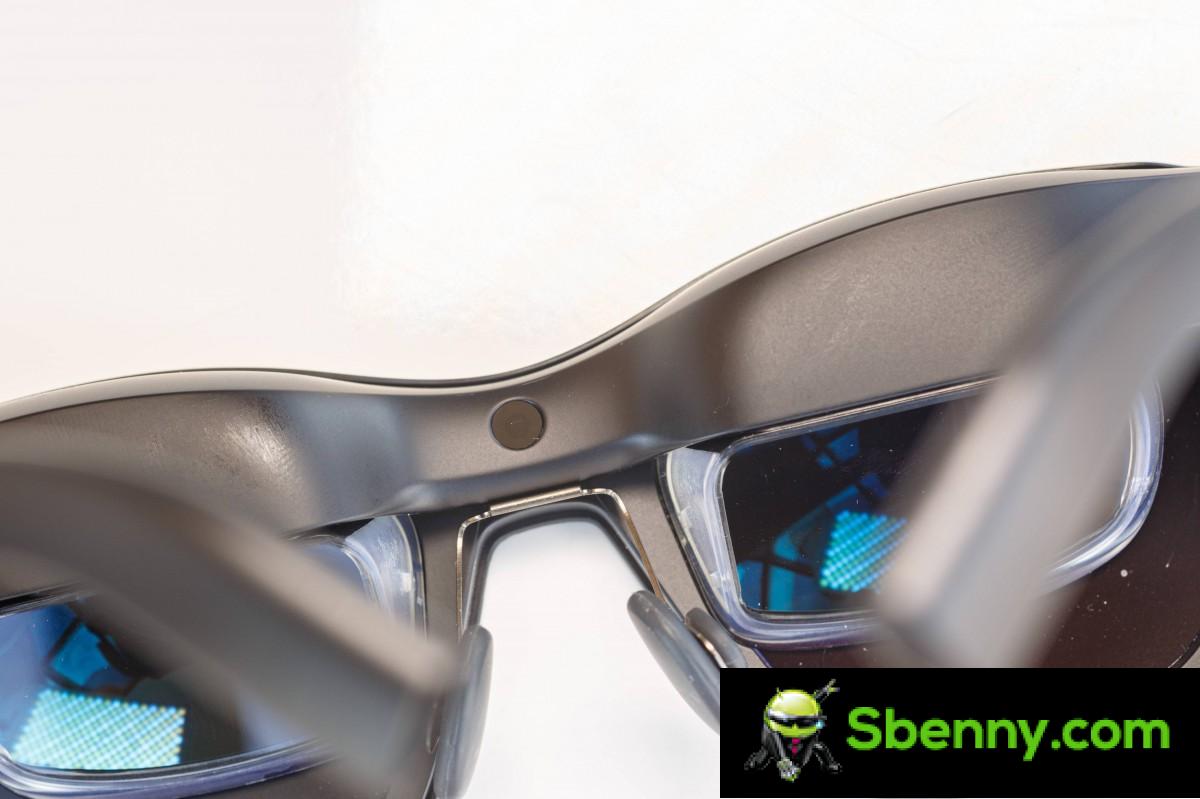
Finally, we have to commend the goggles that are part of XREAL Air. Having to wear glasses all the time, personally and having worn quite a few pairs, this reviewer can appreciate when the ergonomics are right. The hinges on the arm are stiff enough to stay securely in place but also loose enough, with enough outward give to not crush the wearer’s head. Gain 20 degrees of outward movement from the hinges. Speaking of the hinges, these also offer a unique vertical adjustment option. The hinges snap vertically in three stages so you can adjust the vertical viewing angle. You really can dial in XREAL Air goggles for a comfortable fit and viewing experience.
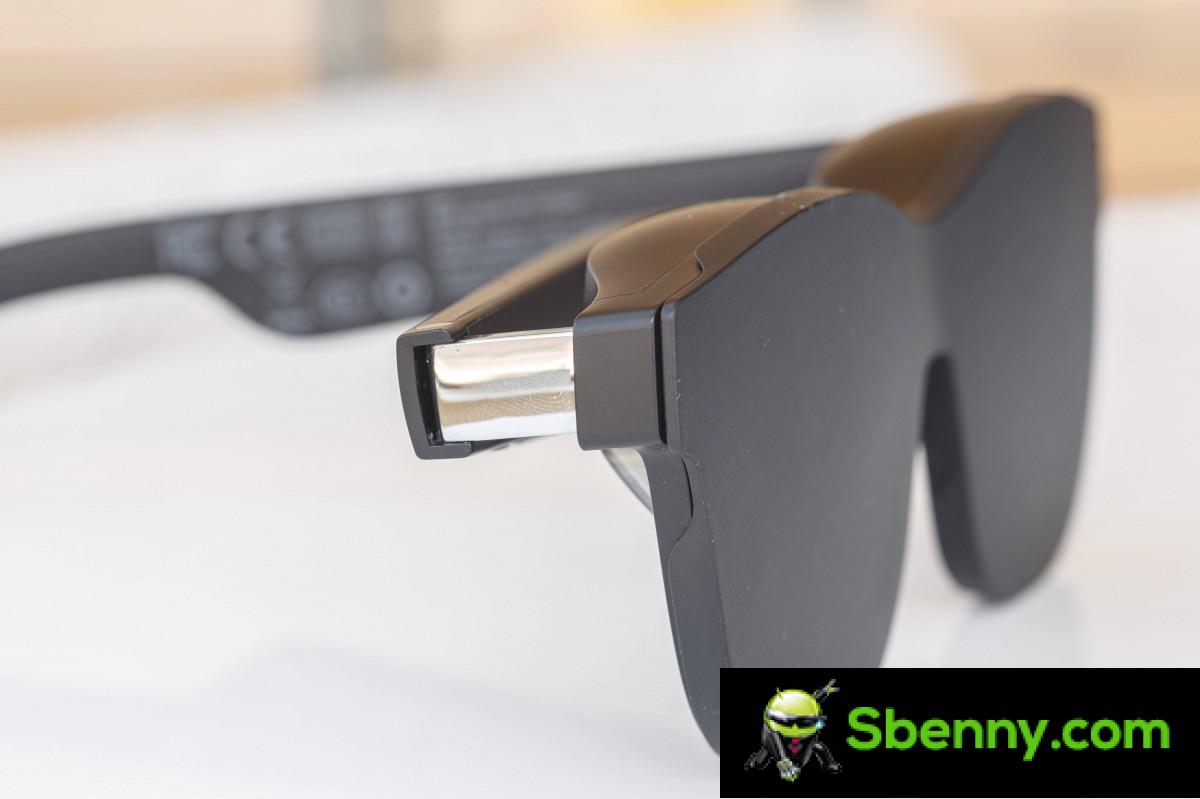
The tips at the end of the arms and the entire arms, for that matter, have no sharp edges that could dig into the skin. The surface of the plastic, while not rubberized, is still soft enough to feel comfortable on your face.
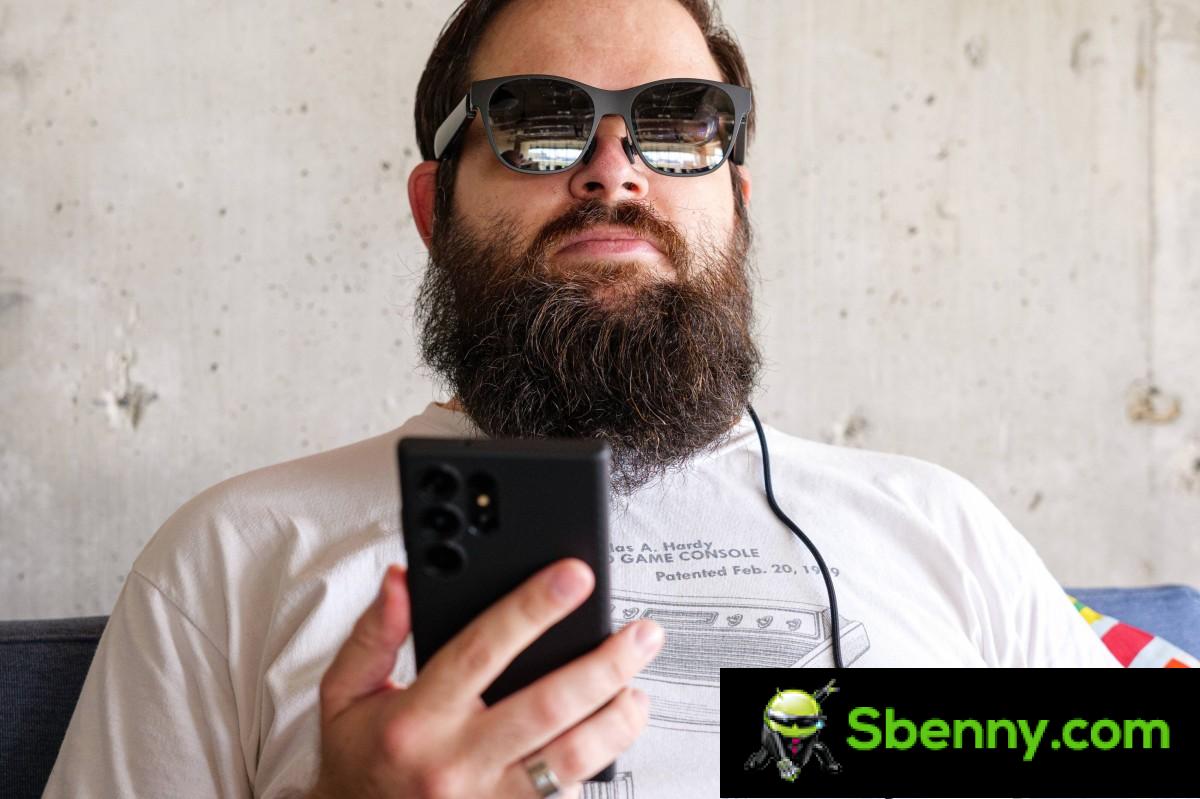
The only real ergonomic complaint we have with the XREAL Air is the front-heavy design. If you have a more sensitive nose, you will likely experience some discomfort with extended use. Switching to alternative nosepads felt much better for this reviewer, personally, but your mileage may vary. It’s also not like the glasses are actually that heavy, and we can’t immediately think of a way to make the design weigh less on the nose without compromising the hardware, so it is what it is.
XREAL Beam, operating modes and features
The XREAL Beam is a cute looking gray device about the size of a compact power bank 105.8mm x 65.86mm x 18.2mm AND 153 grams. Most of that weight is probably the 4870mAh battery, which according to XREAL is good for everything 3.5 hours of operation. The small device also has some computing power on board, enough to need active cooling, provided by a built-in fan, which is sometimes audible, but never distracting or intrusive. It’s not that the beam is expected to reside near your ears anyway.
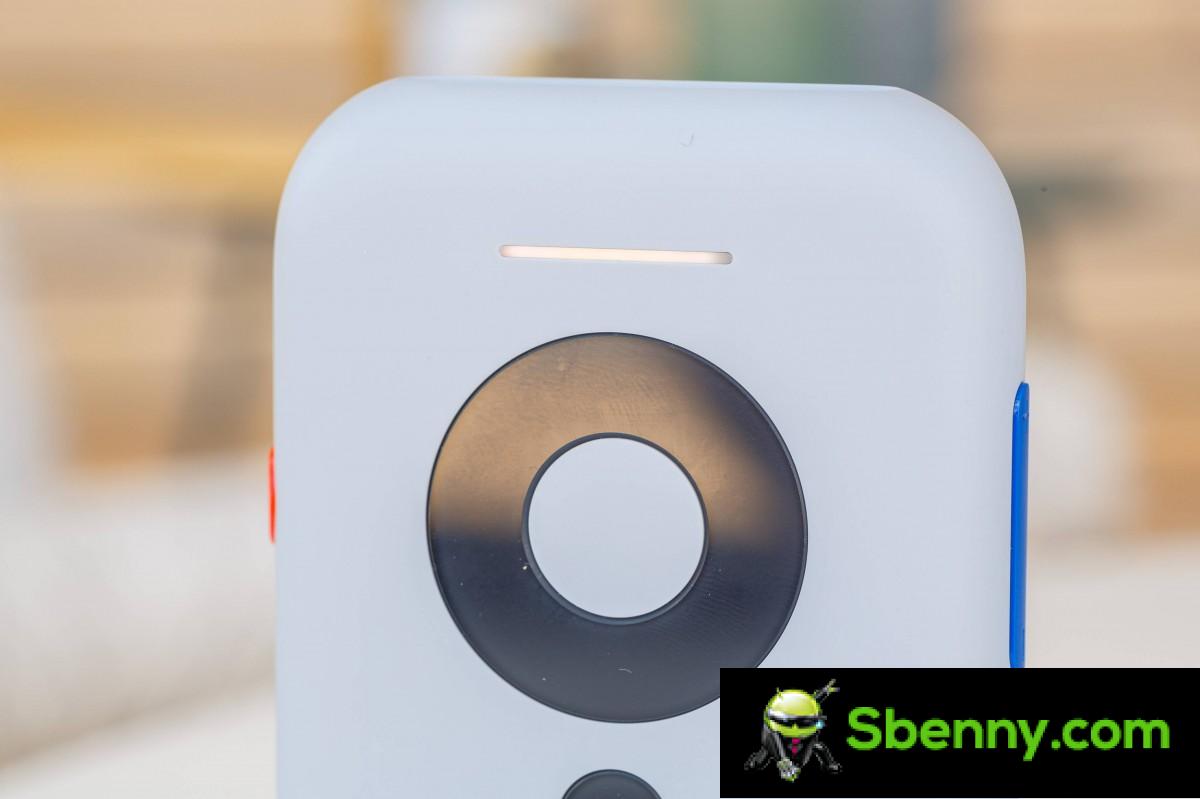
There are a surprising number of controls and I/O on the Beam. First, two USB Type-C ports are at the bottom. One is meant exclusively for connecting Xreal Air glasses, while the other can receive video input via Type-C and power. The beam can charge up to 27W via PD, it can run while it’s charging and should go from dead to 50% in about 30 minutes. In the next section of the review, we’ll talk at length about the Beam’s connectivity support, both wired and wireless.
In terms of controls, the Beam has an iPod-inspired D-pad on the front along with back and OK buttons. There’s a volume switch on the right side and a “mode dial” button on the left side. A hidden button on the top controls power up, but the device also turns on automatically when you connect it to XREAL Air goggles. A multicolor status LED strip on the front shows the current battery level.
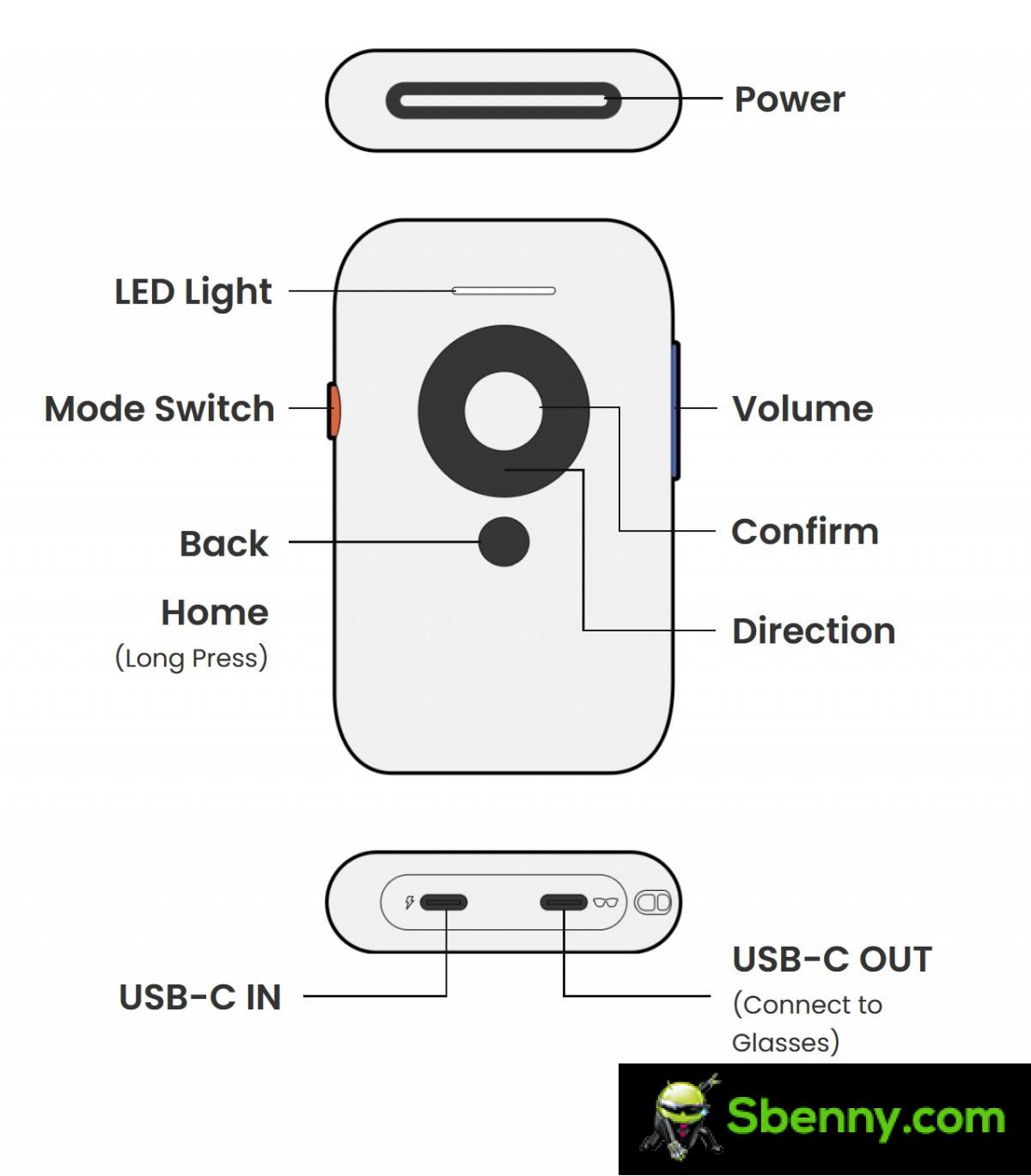
As we’ve already mentioned, the Beam has some built-in processing power and is theoretically capable of running “apps” on its own. Only two tutorials are currently available, with more for streaming and gaming likely to come. The primary use case for Beam currently is to enable wireless casting (Miracast and AirPlay) to the XREAL Air goggles. It does this quite well while also allowing for 3 DoF head tracking via the Air’s built-in sensors. Basically, this means that the position of your head can be monitored in terms of side-to-side, up-and-down, forward-and-back movement, as well as side-to-side and up-and-down tilt. The big difference from something like a VR headset, which usually has 6 DoF, is that you can only look around your environment, but not necessarily “move”.
The beam has a total of three modes of operation. Smooth Follow ensures that the image follows your gaze and is always in the center. It’s like the default “static” mode of operation of the XREAL Air goggles, without using the Beam, but manages the effect by tracking. This, unfortunately, means that the image “lags” your movements and gets quite blurry as you move. This is an unfortunate and constant drawback of using beam.
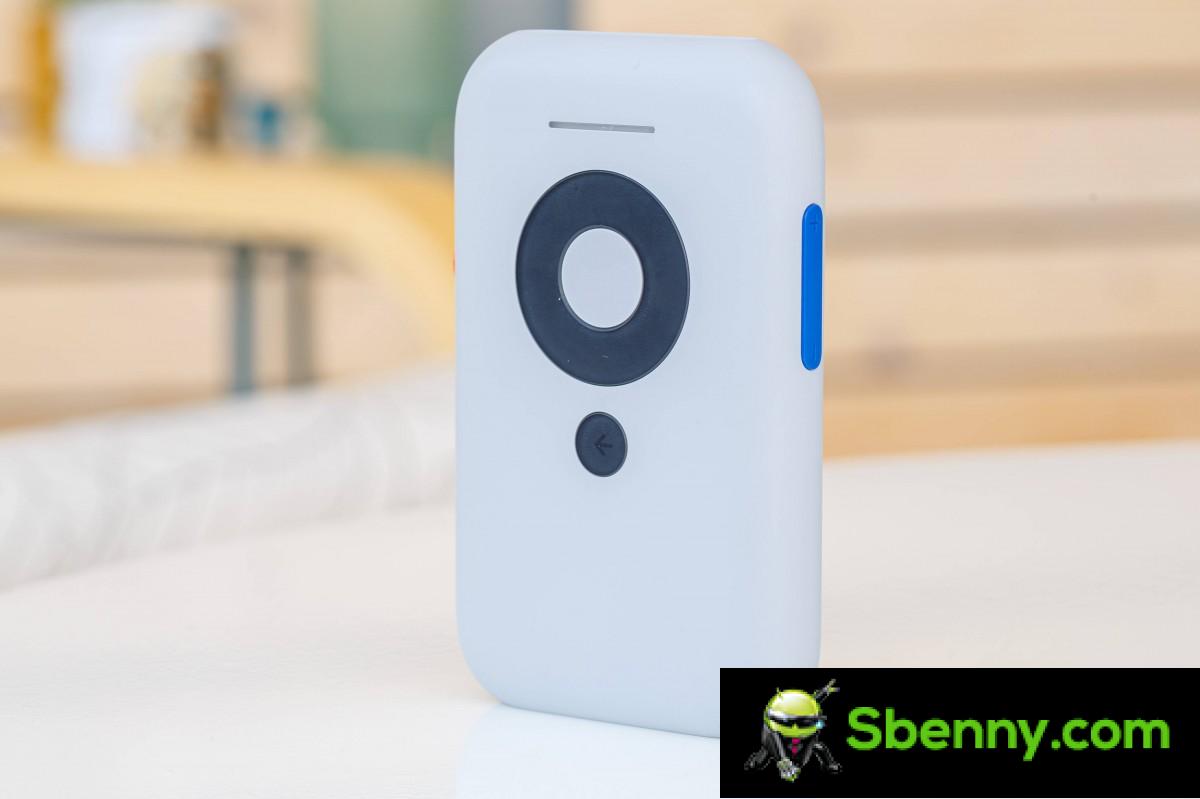
The Beam also has a Sideview mode, which behaves like Smooth Follow, but the image only takes up one corner of the field of view. You can choose which angle it is, and the idea is that you can let a content constantly follow your gaze, but not occupy its center so you can look through the glasses and do other things. Potentially even move.
Finally, there’s the Body Anchor mode. Using it, the image still follows the movements of the head up and down, left and right and back and forth. However, you can rotate your head side to side and up and down to freely explore the edges of the image. This is intended to display an image that exceeds the headset’s field of view and simulate a rudimentary 360-degree spatial imaging experience.
Smooth Follow and Body Anchor modes allow you to freely adjust the size of the display being projected and also the perceived distance at which it is being projected from your eyes. The latter is good enough if you happen to have a mild case of nearsightedness, but it’s not as good as proper optical compensation and can only go so far. This reviewer has -1.75 nearsightedness in both eyes, and the depth setting wasn’t enough to get a perfectly sharp image. The included custom prescription lens accessory for XREAL Air is what you need to correct it correctly.
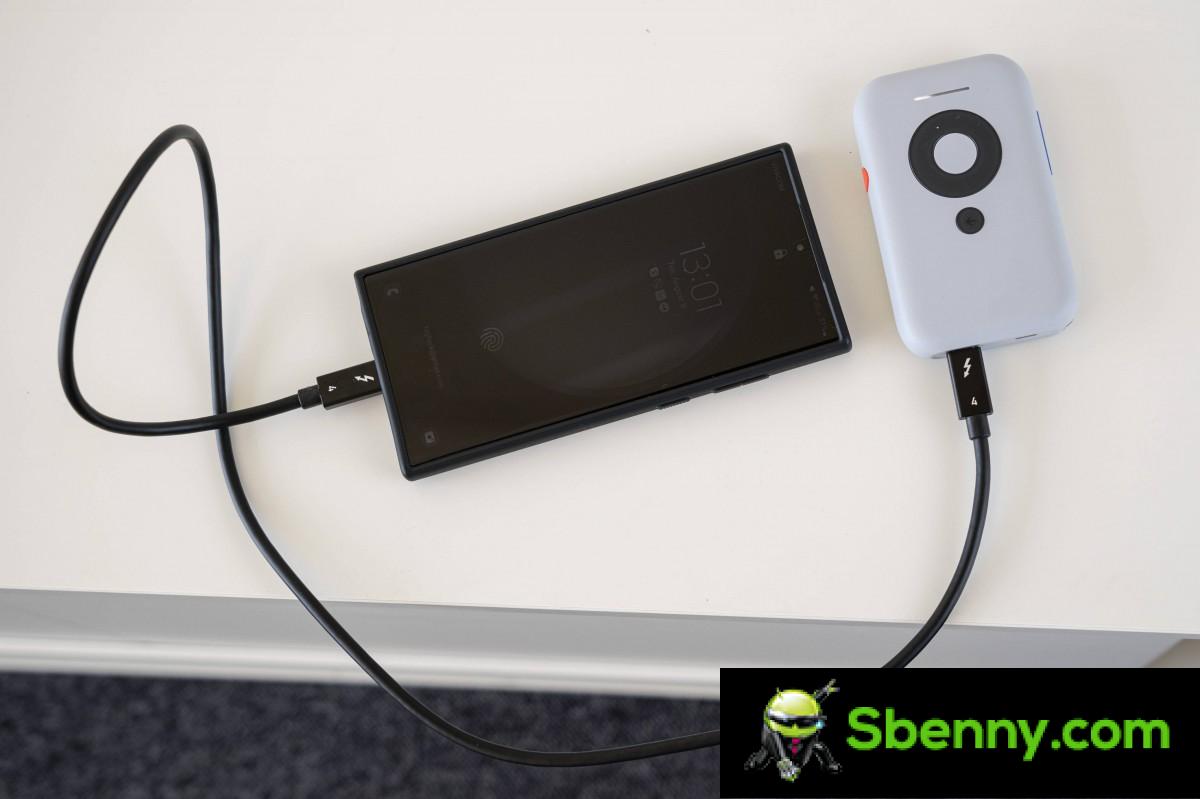
Despite some downsides, such as blurry image during motion, XREAL Beam is a powerful addition to XREAL Air, opening up many more possibilities and use cases. Apple users especially should look into it for the AirPlay casting feature. The fact that 3 DoF tracking actually works is also nice to see.
BTW, there is another way to actually get 3 DoF tracking and working without the beam. All you need is the XREAL Nebula application for Android on a smartphone already compatible with XREAL Air glasses via wired connection.

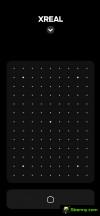
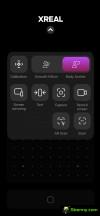

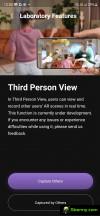

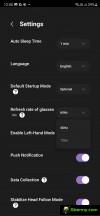
Nebula application
The Nebula app isn’t much to look at from the phone side. It offers a trackpad for on-screen input, alongside a home button, and also leverages the phone’s accelerometer to generate a spatial pointer controller within the Air goggles interface. The interface in question is called “AR Space” or “MR Space” and offers a 3 DoF head tracking home screen experience along with a few apps. In particular, there is a “space” web browser and a YouTube player.
To be fair, not all of the icons in this interface do anything, and most of the features that work basically boil down to launching the browser app. The browser, however, is a nice addition, and AR/MR Spaces has another intriguing trick up its sleeve. If you scroll to the far right of the main UI, there is a feature called “XR Streaming”, which allows you to connect the XREAL Air goggles via your phone to a running Steam VR compatible Windows PC and try out a few apps Compatible VR and Games.
The phone acts like an emulated VR controller in this mode and the whole thing actually works amazingly well. However, we did experience an unfortunate amount of lag and latency when using it, and there are plenty of limitations that come with 3 DoF tracking and the single controller being emulated instead of two. However, the fact that it even works in any capacity is impressive. Also, many VR “experiences” that are more passive in nature can be enjoyed this way, even if the VR gaming is limited at best. There’s a great article on setting everything up with XR Streaming here.
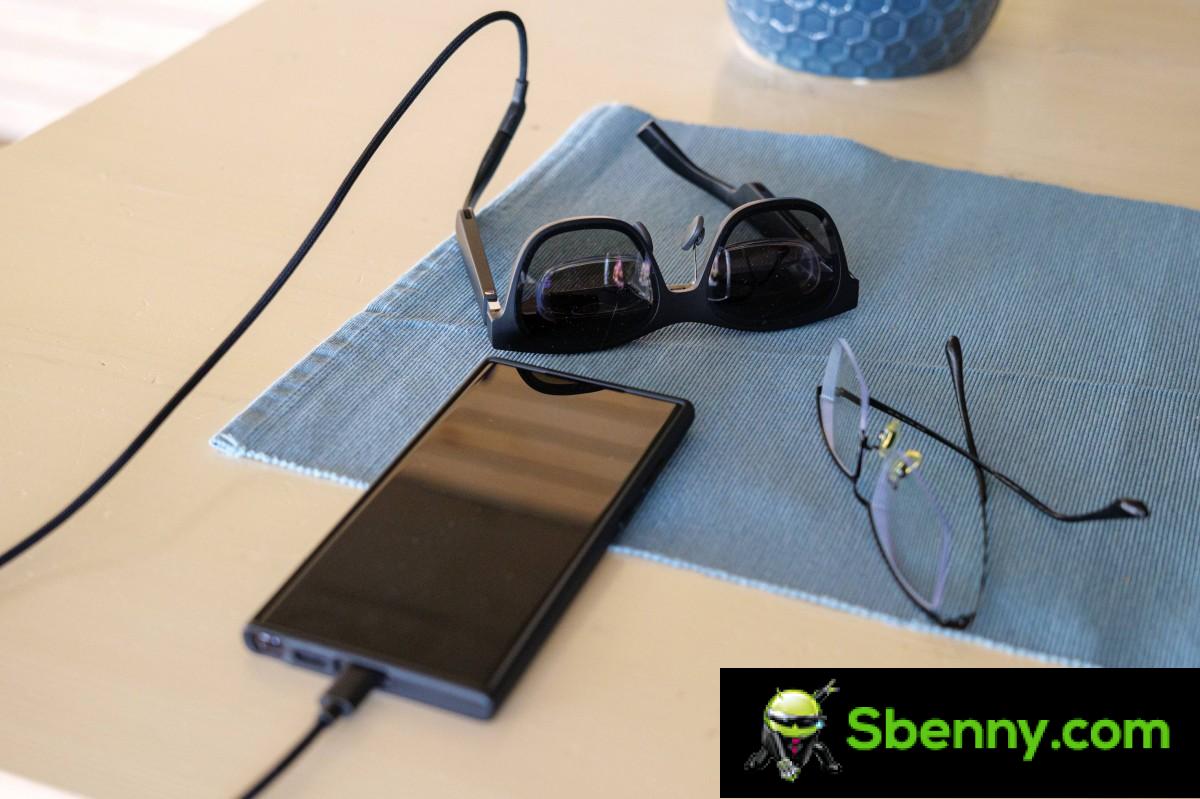
One thing that seems to be a woeful omission about the XREAL Air goggles, whether through using the Nebula app on a phone or the Beam, is the ability to properly stream 180-degree SBS video on the goggles with proper tracking. There is some sort of workaround using VLC on your phone and regular screencasting, but it’s very fiddly and far from perfect. We hope XREAL provides an adequate player for spatial video, ideally either via the Nebula app or Beam, and better yet, one with support for something like DLNA so that video can be streamed from a home server or NOS.
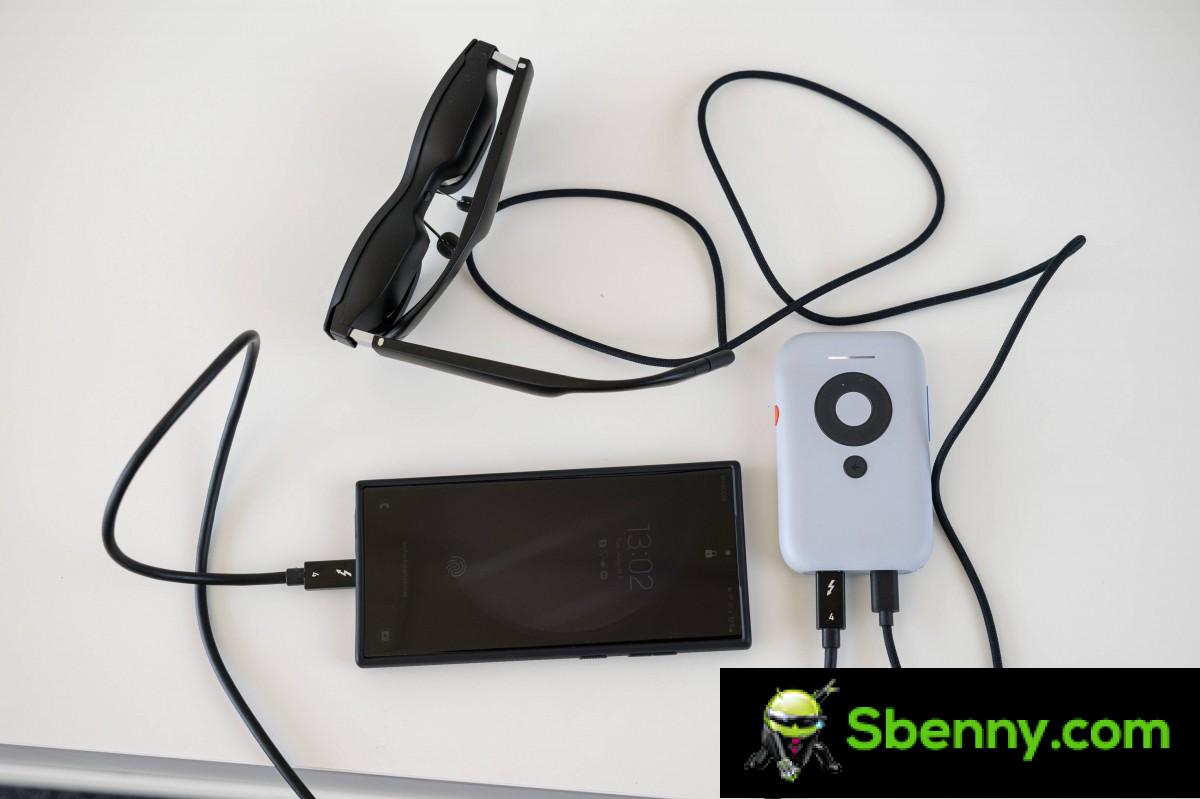
The good thing to note on this front is that the XREAL community, formerly Nreal, seems to be very active and new 1st and 3rd party apps and features are popping up all the time, so it may only be a matter of time.
Compatibility and optional adapter
Device compatibility for XREAL Air goggles is a bit confusing. You can check out the official compatibility guide here. All the glasses really need to function is a USB Type-C port with USB alt-mode support for Display Port output. The glasses themselves aren’t too power hungry, so most devices don’t struggle to keep them powered.
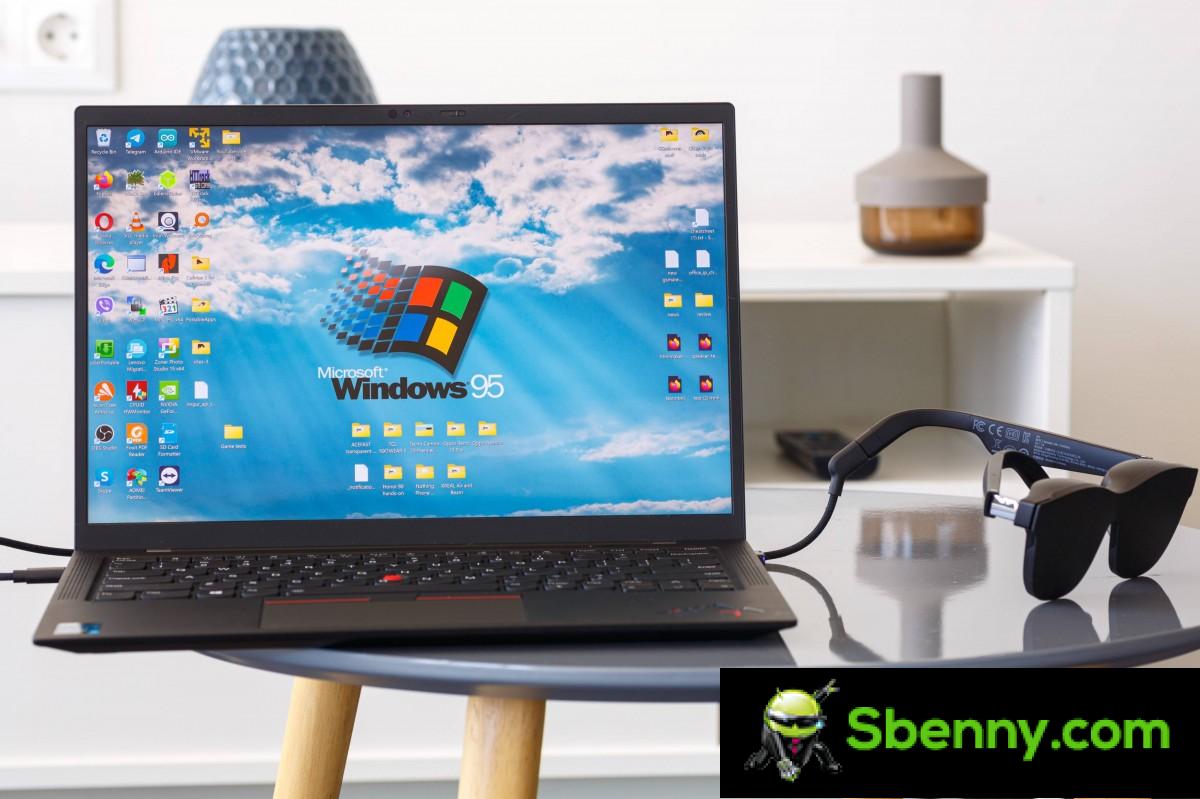
What does that mean in real terms? Let’s start with laptops since they are easier to summarize. You’re good to go if your laptop supports DP alt mode over USB Type-C. This should be listed on the laptop spec sheet as they tend to be well detailed. We tested on a Lenovo ThinkPad X1 Carbon Gen 9, a 2021 ASUS Zephyrus G14, and a MacBook Air M1 with perfect success. We know this is a somewhat arbitrary list, but it illustrates the main point: if you have DP over Type-C, it will work.
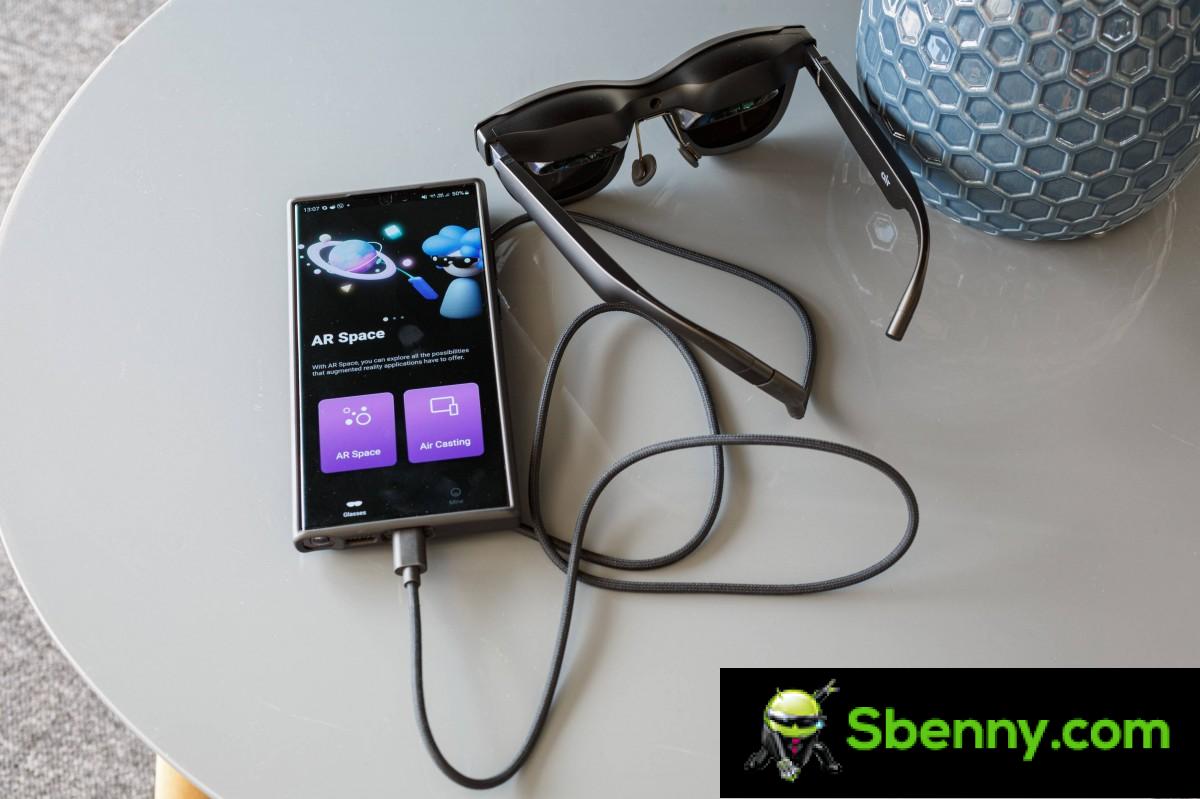
Things are a little more complicated from a telephone point of view. Technically, out of the box, with no additional accessories, the XREAL Air is an Android-only accessory since, well, there’s no Type-C port on iPhones.
Some Android devices support Display Port over USB Type-C, but there’s no easy way to know which ones. A good rule of thumb includes that it’s generally a flagship feature, and you should have better odds with Samsung, Huawei, and OnePlus devices. Again, you have to search around to see if your phone has DP over Type-C. In terms of phones, we have succeeded with a Samsung Galaxy S23 Ultra, Galaxy Z Fold 4 and an Oppo Find X5 Pro.
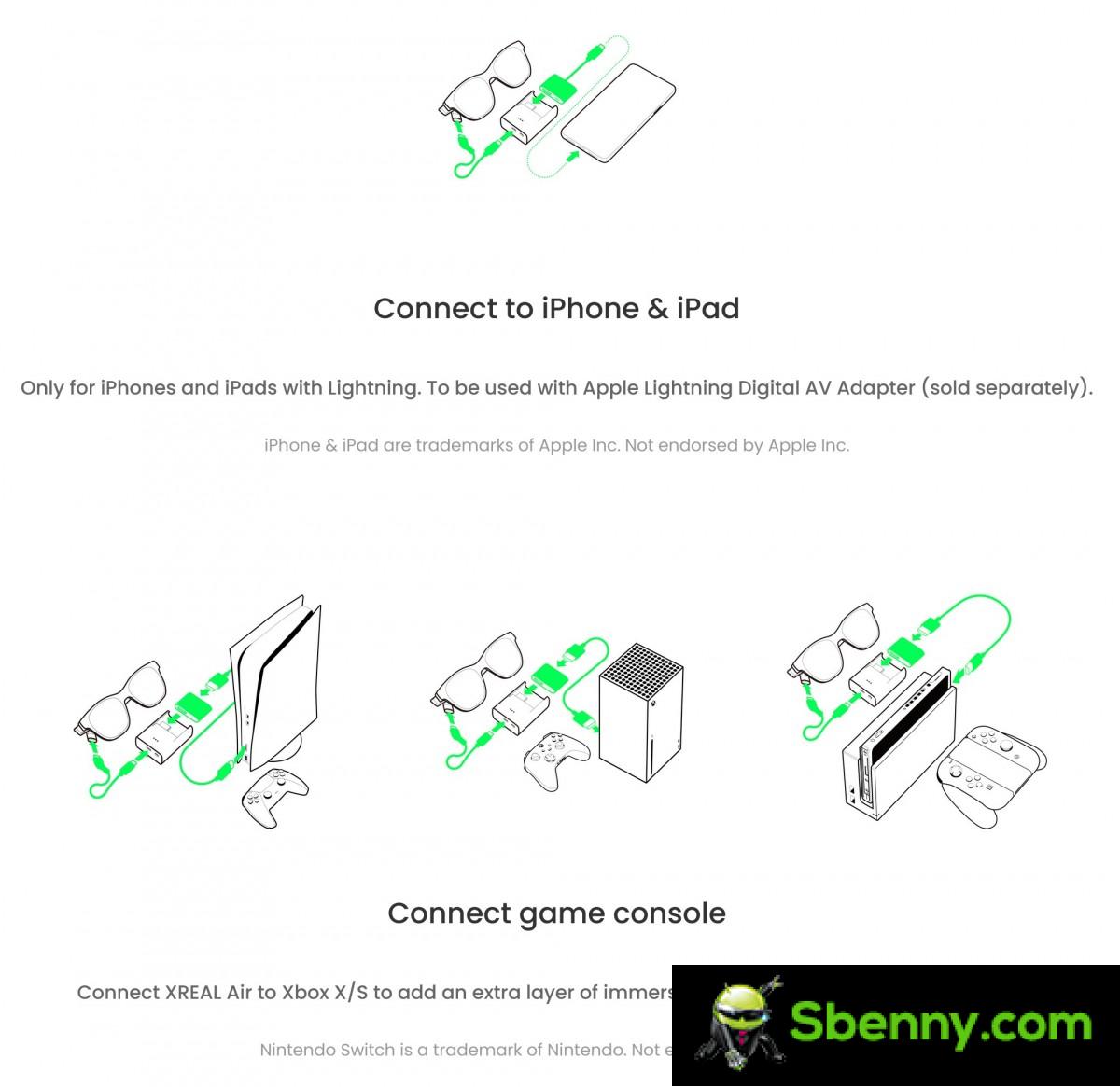
Let’s go back to Apple compatibility. Again, there is no out-of-the-box iPhone support. However, XREAL does sell something it calls the “XREAL Adapter”. It basically takes an HDMI signal and converts it to Display Port for the glasses. If you buy it, along with Apple’s official Apple Lightning Digital AV Adapter, virtually any recent iPhone and iPad with an AV-capable Lightning port adapter will also work with XREAL Air glasses.
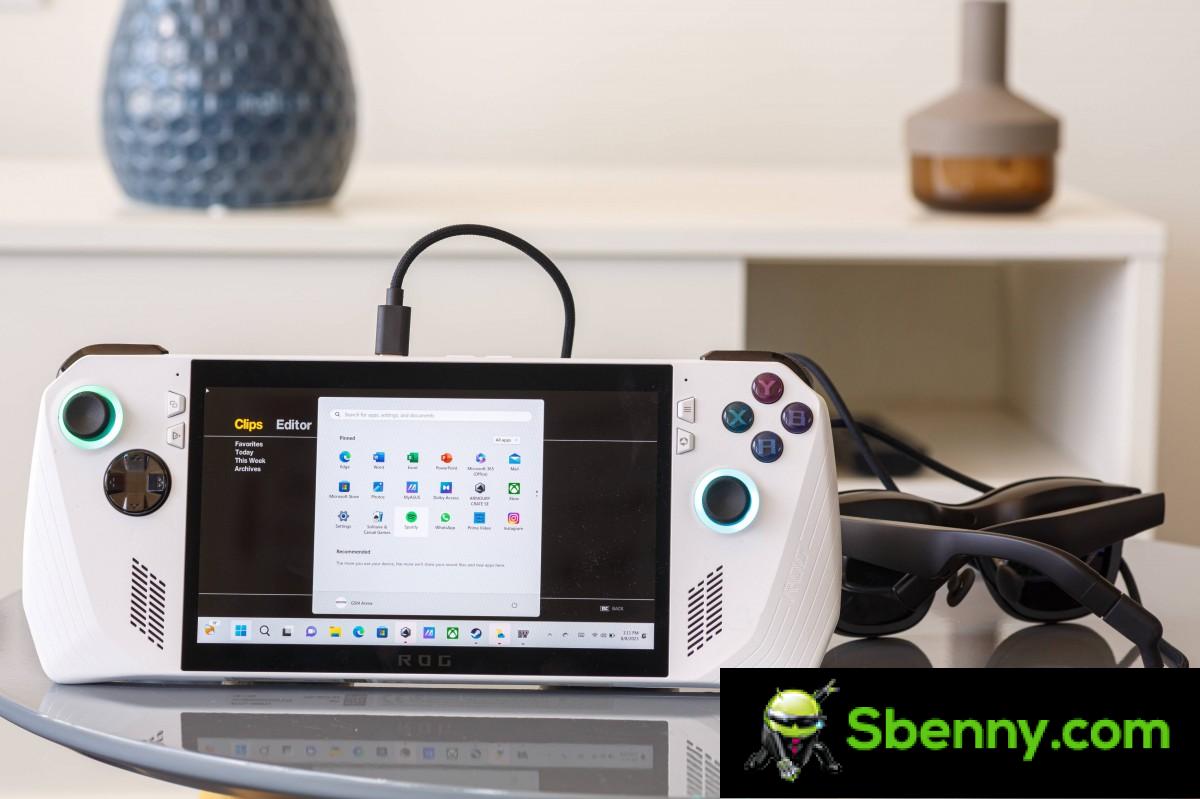
The XREAL adapter also comes with a sort of female-to-female HDMI “coupler” that theoretically allows any HDMI source device to “beam” to the XREAL Air goggles. XREAL confirms that it works with Microsoft Xbox S/X series, Sony PS4 slim/5 and Nintendo Switch. However, XREAL did not provide us with the adapter. therefore we cannot verify these claims, but we can say with certainty that the Nintendo Switch does not work docked directly to the glasses. The Valve Steam Deck, on the other hand, supports DP via its Type-C port and simply works by plugging directly into the goggles. The same goes for ASUS ROG Ally.
And then there’s XREAL Beam. Its main function is to provide wireless transmission capabilities to XREAL Air goggles. In fact, we tried both Miracast on a supported Android device and AirPlay on an Apple iPhone, and both worked fine. Wired connectivity support on the Beam also appears to build on regular Air support.
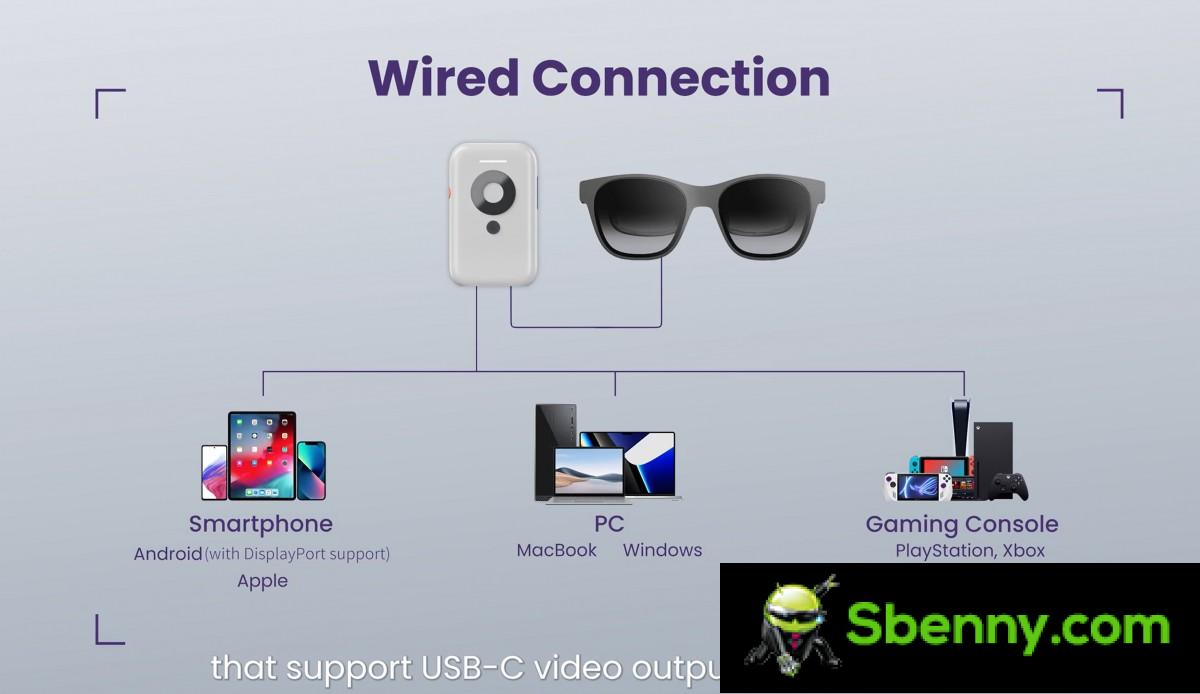
From our tests, it appears that the Beam accepts Display Port (DP) over Type-C, just like the glasses do without any limitations. We can also confirm that, unlike the glasses themselves, the Beam supports direct connection to the Nintendo Switch. As for the other advertised game consoles, such as the Xbox and Play Station models from the Beam support list, these require the use of a very strange HDMI to Display Port (DP) and USB Type H cable. We grabbed one straight from XREAL for testing, but don’t believe it comes in the box with the Beam. Be prepared to grab one in case you want to connect an HDMI source to the XREAL Beam.
Performance and energy consumption
Unfortunately, since the XREAL Air’s displays are by no means traditional, we can’t measure their performance characteristics. We’ll have to stick with some of the official specs here and our own subjective impressions. The virtual display ends up being very well centered in your field of view which is great. It doesn’t fill it completely, far from it, and you always get a blank space around the display. The official specs state a 46 degree field of viewwhich sounds more or less right.
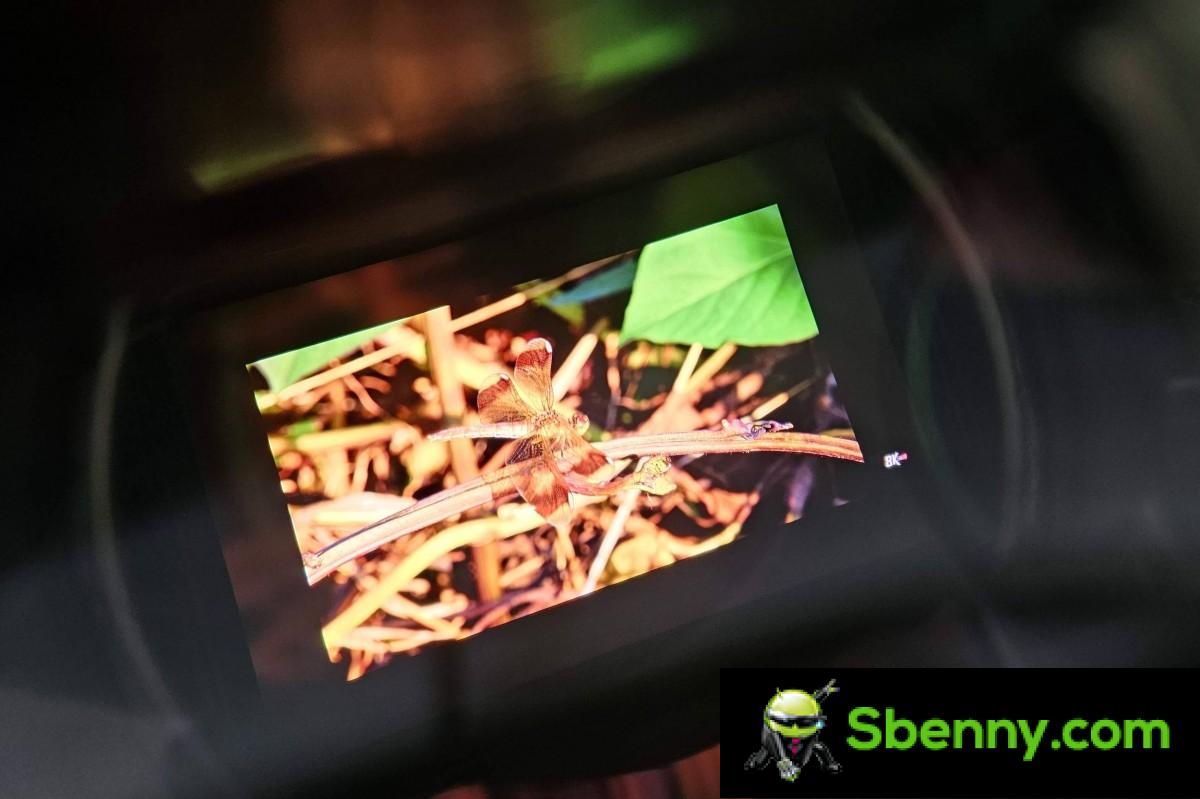
The two OLED displays have a native resolution of 1920 x 1080 pixels. In practice, this is sufficient even for small texts. The image produced by XREAL Air glasses is very sharp, surprisingly. The issue of display size is a bit more difficult to address. Going by the official numbers, XREAL Air can “project” a 130 inches display equivalent to a viewing distance of approximately four meters away in normal operating mode. When working in MR Space mode, the size can grow up to 201 in seen from about six meters away. Subjectively, we’d say the picture isn’t overwhelming but still large enough to count as a cinematic experience. The quoted The PPD (Pixel Per Degree) figure is 49. In practice, the image is very sharp.
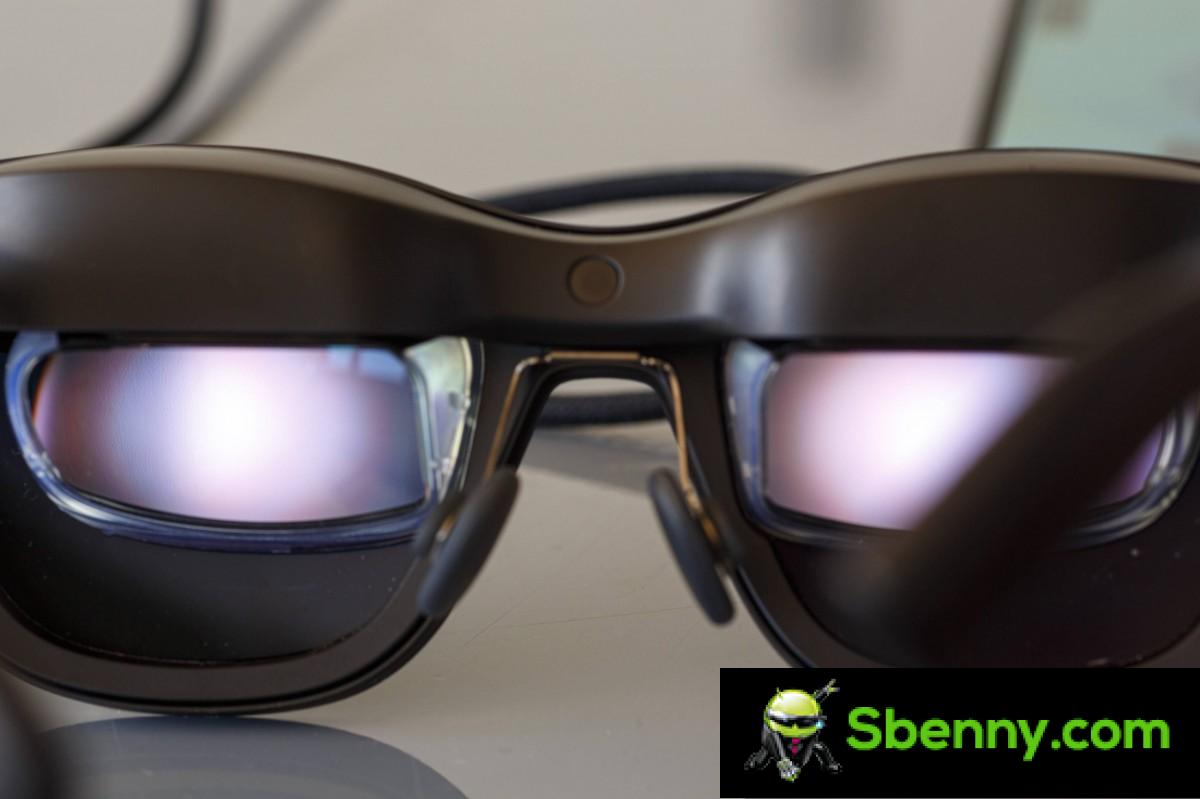
In terms of brightness, the manufacturer quotes up to 400 nits of perceived brightness. We found that the display never gets bright enough to be uncomfortable. Without bright solid shades, there is not enough brightness to drown out the surroundings and “punch through” the transparency. That said, once you get used to the fact that you’ll always see the outside world and focus your attention on the content, even the lowest brightness setting becomes usable. It’s a strange effect that’s hard to put into words. All you need to know is that XREAL Air remains usable in virtually any circumstance. Higher brightness levels can cause eye strain in some people. That said, the Air glasses have achieved TUV Rheinland certifications for low blue light emissions and no flicker. This provides a little extra peace of mind, as these are displays you wear inches from your eyes for extended periods of time.
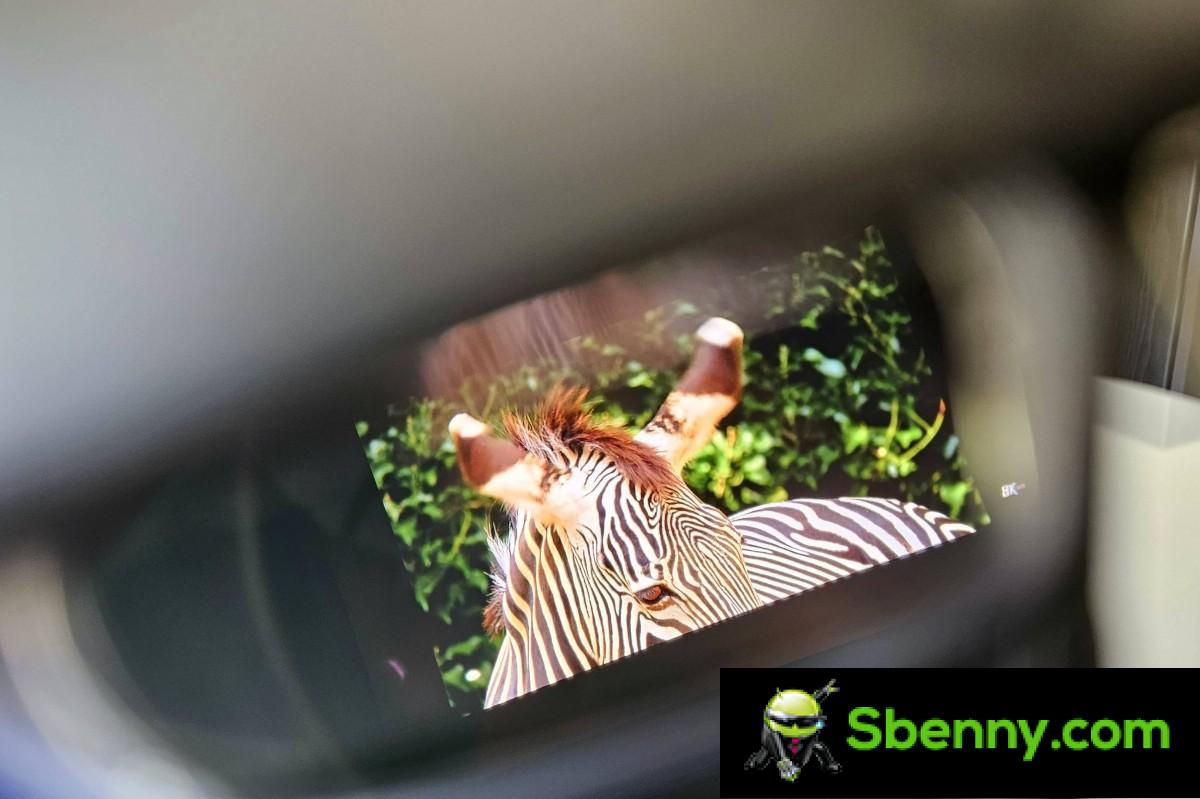
XREAL Air produces surprisingly vivid and saturated colors. The panels themselves are standard 8 bits. The official specifications state it 108% RGB coverage, which is impressive but is somewhat hampered in practical terms due to the nature of the display setup.
The panels on the goggles work to a standard 60Hz. However, they can be overclocked to 72Hz via the Nebula app. We agree with that figure, especially since the XREAL Air goggles aren’t meant for VR content, where refresh rate matters much more. On a more positive note, pixel response time is good. There is also little input latency. We were able to play on XREAL Air and played some platformers that required reasonable jump time accuracy with no issues.
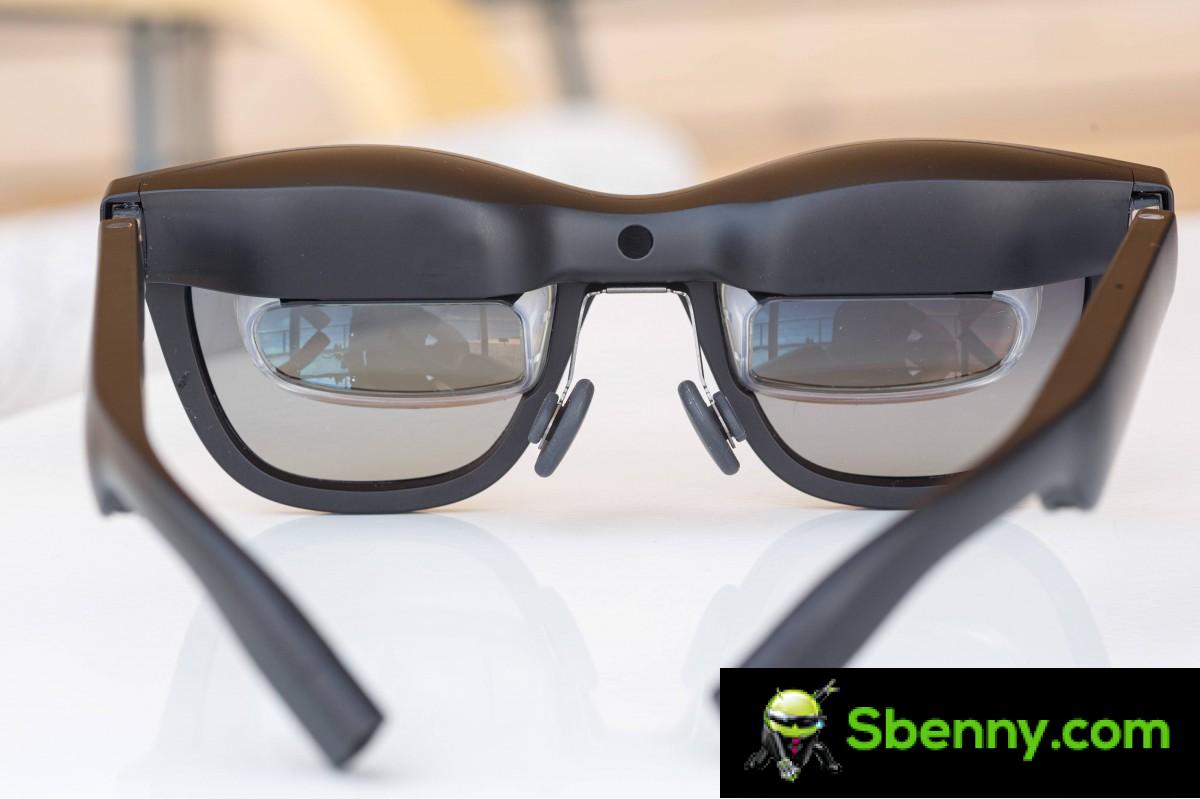
On the other hand we weren’t impressed with the sharpness of the image and especially things like finer text, while the glasses worked in “tracking mode”. That is when the glasses are connected to a phone and running the Nebula app for AR/MR spatial mode or connected to XREAL Beam. In both cases, the display is static in space or follows head movements “smoothly” in space. Both cause a lot of flickering and image smearing and aren’t quite as sharp as using the glasses in their “default” direct-as-screen mode with no tracking involved.
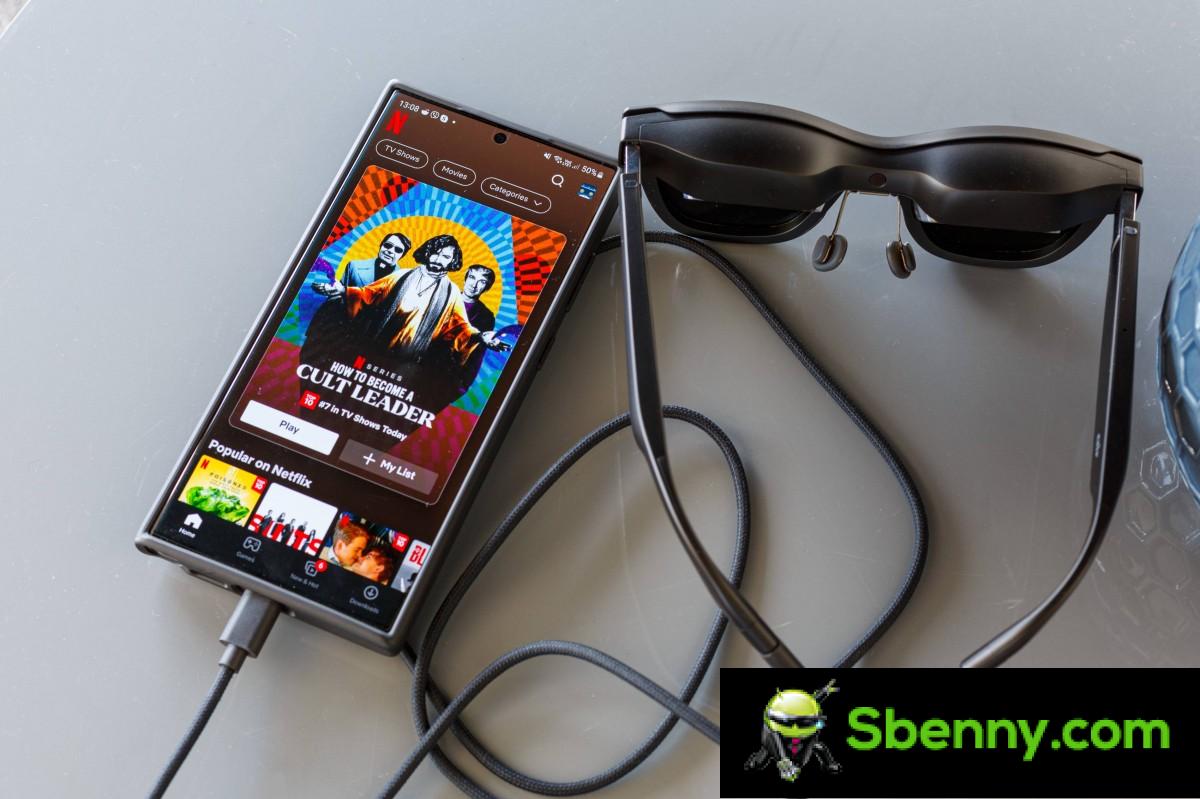
Because the XREAL Air glasses are powered entirely through a Type-C port, one of the few actual tests we were able to run on them was to measure power consumption. We are happy to report that the glasses are quite efficient. With a fairly static image on screen, such as browsing or working, they drew around 1.1W and this surprisingly doesn’t fluctuate substantially regardless of the brightness setting. When playing a video with sound, the glasses used between 1.5W and 1.6W. In more practical terms, watching a two-hour movie from Netflix on the Samsung Galaxy S23 Ultra with XREAL Air turned on consumed about 27% battery power, which is perfectly reasonable.
You should get a couple
Just like the TCL NXTWEAR S eyewear we recently reviewed, the XREAL Air also made its way into the GSMArena office and more people. We all unanimously agree that the concept is really cool and works quite well in most cases. Everyone who’s tired said they’d like to have a pair of AR glasses, though opinions are divided on whether the current market price was justified.
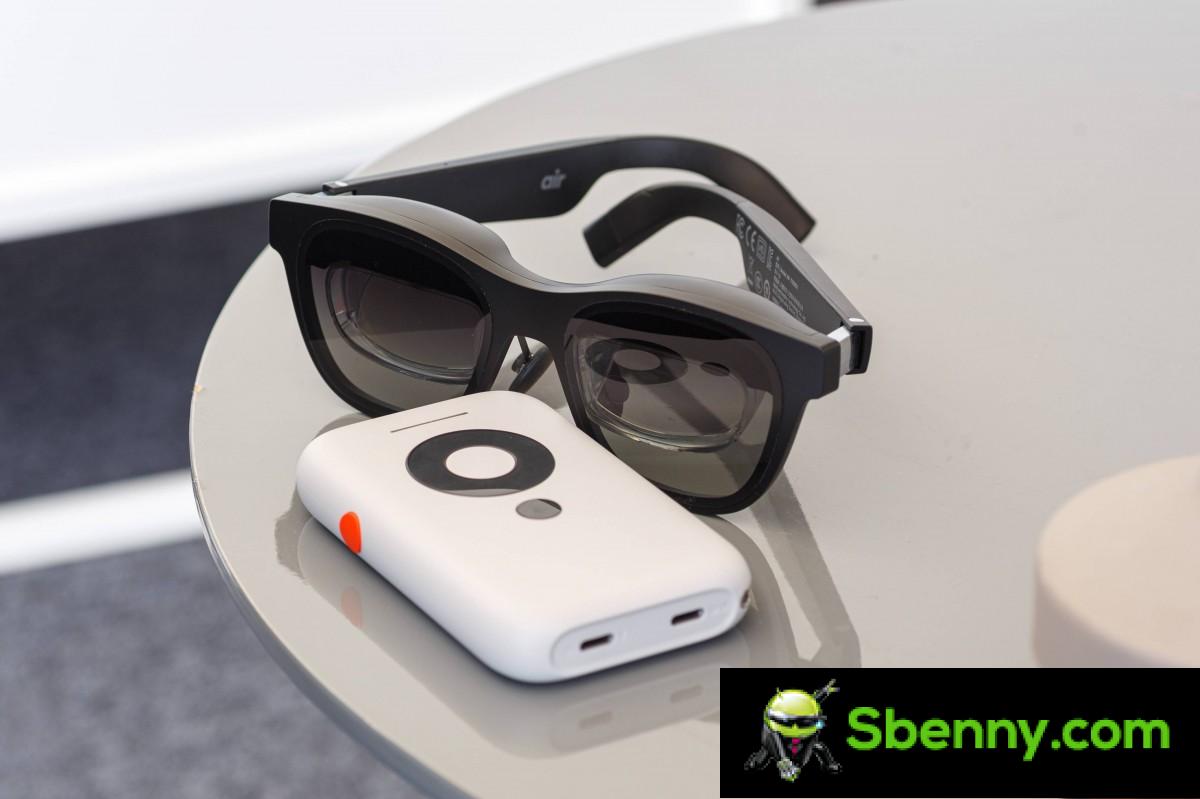
As far as use cases go, the prevailing opinion seems to be that AR glasses make a great travel companion, especially for air travel. Some people have also expressed the desire to have a pair on their nightstand to consume content before falling asleep more comfortably. The game hasn’t really surfaced in the GSMArena employee circle, but regardless, it’s undeniable that there are real use cases for such AR glasses.
Back to the comparison with the recently reviewed TCL NXTWEAR S eyewear, it seems that most people liked the XREAL Air eyewear a little better and for good reason. They are lighter and a little more comfortable. They also offer a way to completely black out the front lenses through the shield attachment. XREAL also has a mostly functional Android app at the time of writing, while TCL’s product is lagging behind. There are also viable ways to actually use the sensors and head tracking on the XREAL Air, via the mobile app or the Beam accessory, and even do some rudimentary VR. However, whether or not you want to do that and the potential drawbacks that tracking said is a whole other question. All in all, the XREAL Air goggles offer the most comprehensive, if at times still immensely confusing, AR package we’ve experienced to date.
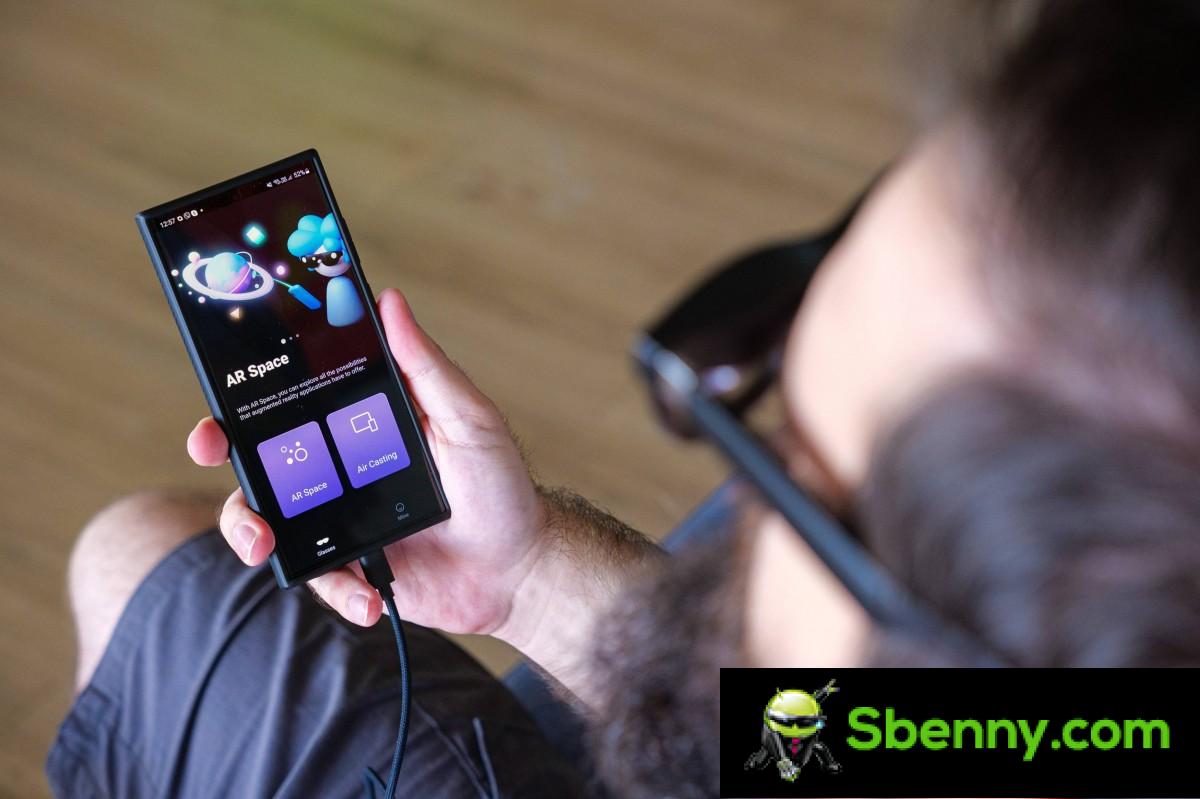
Also, when it comes to design and ergonomics, we have to say that the XREAL Airs are also the most comfortable, adjustable, and accommodating AR glasses we’ve experienced so far. There is still a real possibility of wear over time, particularly around the nose area, but that seems unavoidable with current technology.
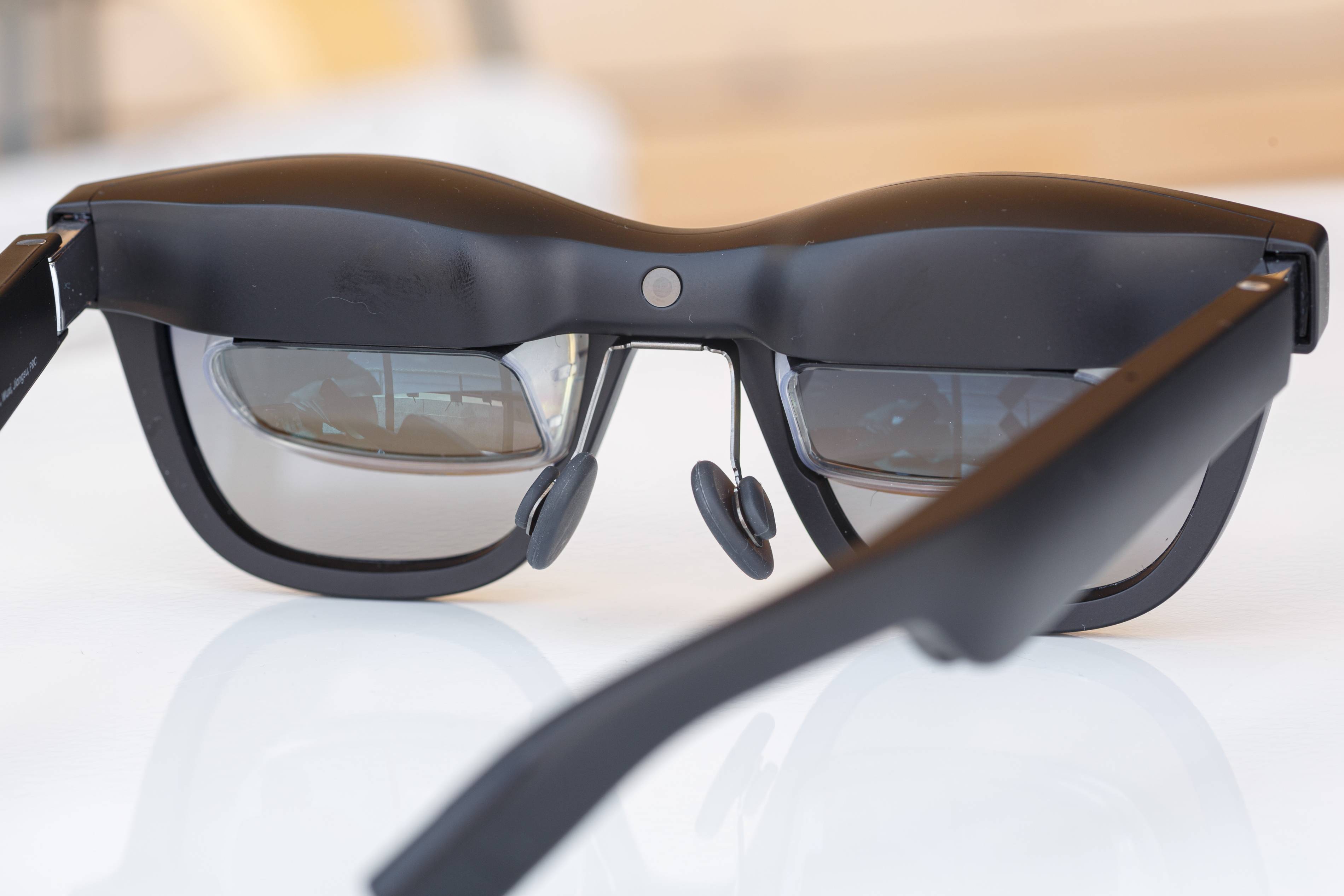
If you find the prospects of AR and XREAL Air eyewear particularly appealing, you can pick up your own pair of eyewear for $379. It’s definitely not cheap at all, and once you’re spending that much on a luxury gadget, you might as well jump in for the Air and Beam package at $488 to unlock the full potential of the glasses. This is especially true if you are an iPhone user as there is no direct compatibility with the XREAL Air goggles out of the box. The XREAL beam alone is currently worth it $109.
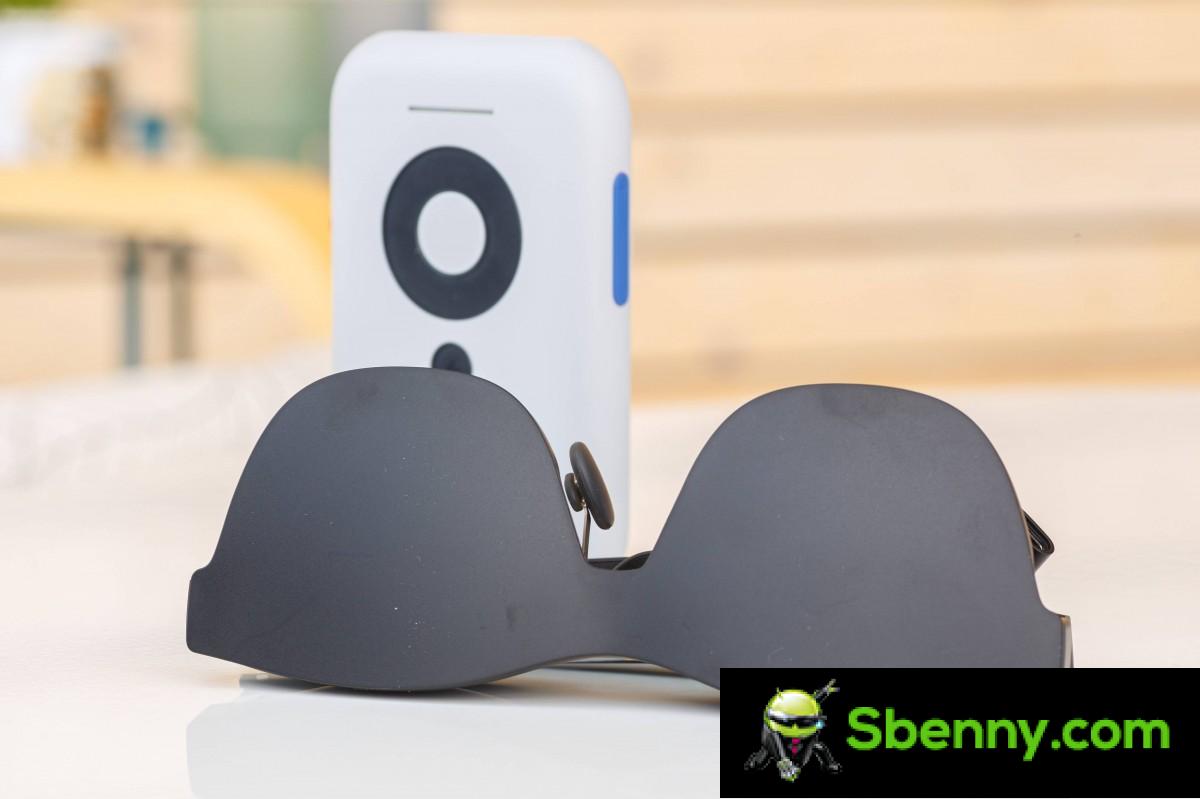
Tell us your thoughts on XREAL Air and Beam in the comments and how you see the AR niche, its current state and future potential.



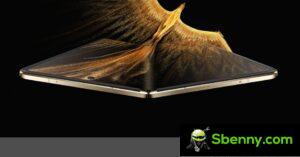
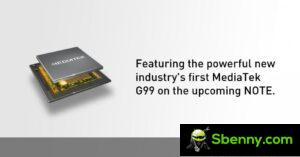
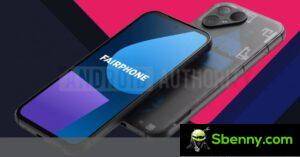

Start a new Thread